Ethical Issues in Adult Nursing
VerifiedAdded on 2020/01/28
|18
|6094
|52
Case Study
AI Summary
This assignment delves into the ethical challenges encountered by adult nurses while providing care to patients with various health issues. It examines relevant legal frameworks, emphasizes the importance of proper communication and interpersonal skills, and analyzes a case study involving Sam, a young woman experiencing both physical injury and emotional distress due to her home life. The focus is on understanding how ethical principles guide nursing practice in complex situations.
Contribute Materials
Your contribution can guide someone’s learning journey. Share your
documents today.
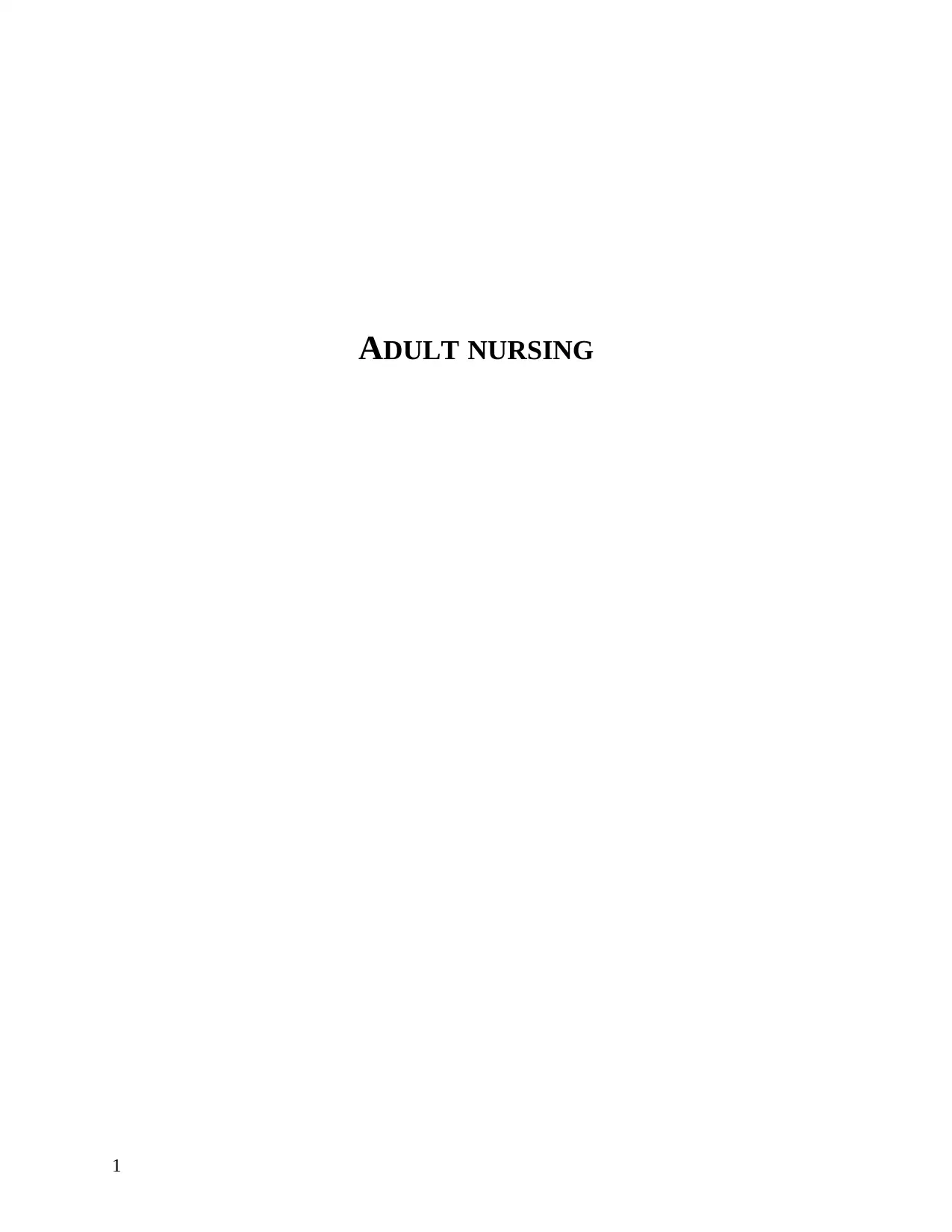
ADULT NURSING
1
1
Secure Best Marks with AI Grader
Need help grading? Try our AI Grader for instant feedback on your assignments.
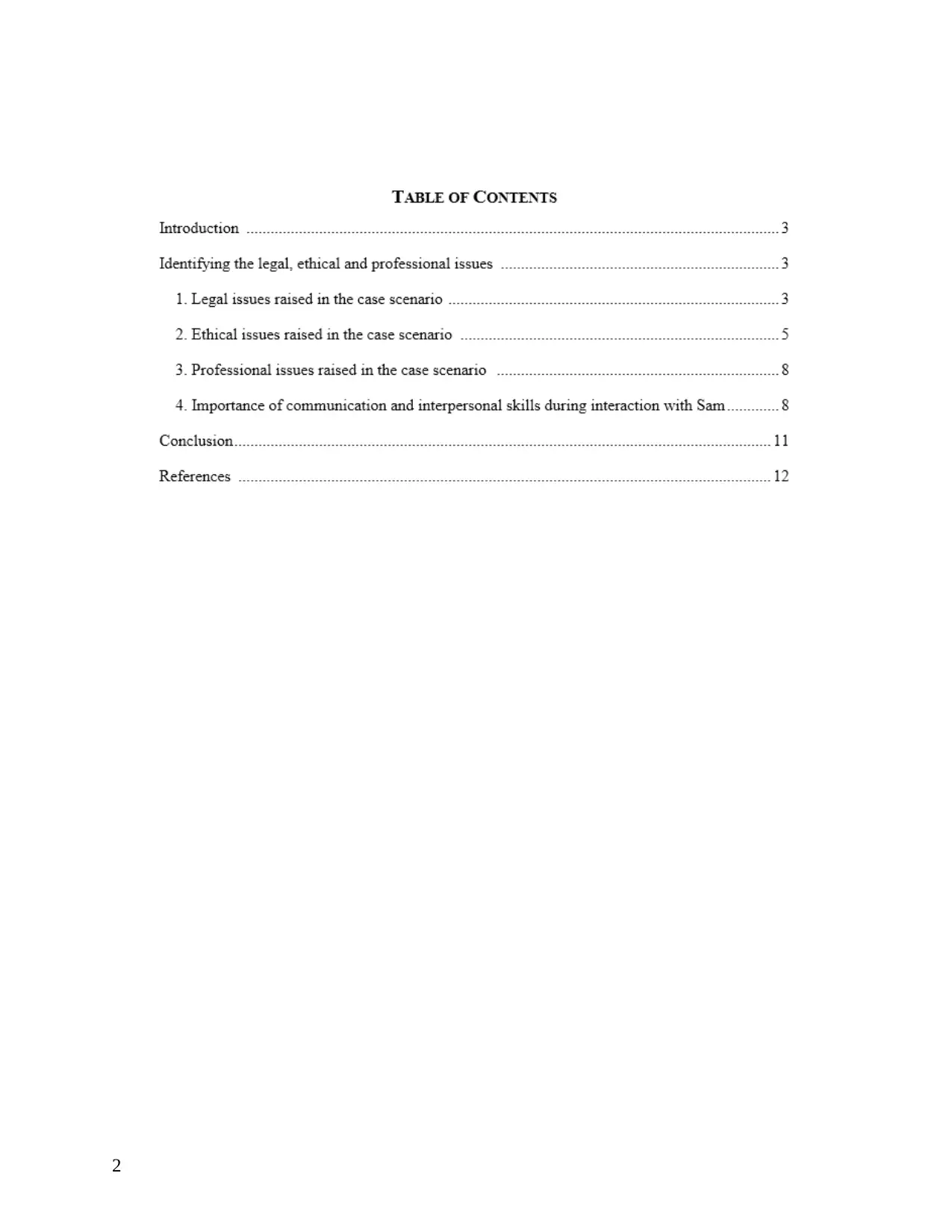
2
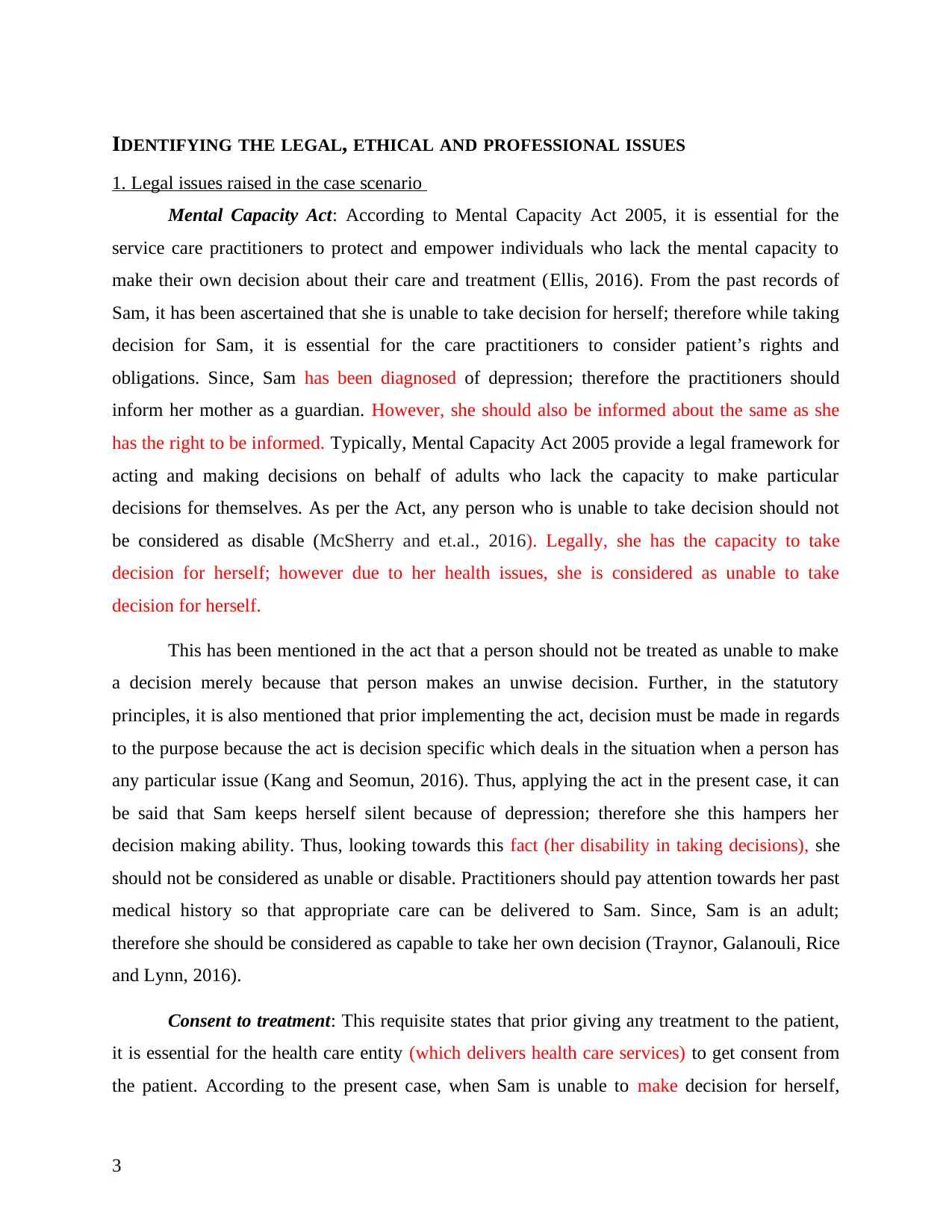
IDENTIFYING THE LEGAL, ETHICAL AND PROFESSIONAL ISSUES
1. Legal issues raised in the case scenario
Mental Capacity Act: According to Mental Capacity Act 2005, it is essential for the
service care practitioners to protect and empower individuals who lack the mental capacity to
make their own decision about their care and treatment (Ellis, 2016). From the past records of
Sam, it has been ascertained that she is unable to take decision for herself; therefore while taking
decision for Sam, it is essential for the care practitioners to consider patient’s rights and
obligations. Since, Sam has been diagnosed of depression; therefore the practitioners should
inform her mother as a guardian. However, she should also be informed about the same as she
has the right to be informed. Typically, Mental Capacity Act 2005 provide a legal framework for
acting and making decisions on behalf of adults who lack the capacity to make particular
decisions for themselves. As per the Act, any person who is unable to take decision should not
be considered as disable (McSherry and et.al., 2016). Legally, she has the capacity to take
decision for herself; however due to her health issues, she is considered as unable to take
decision for herself.
This has been mentioned in the act that a person should not be treated as unable to make
a decision merely because that person makes an unwise decision. Further, in the statutory
principles, it is also mentioned that prior implementing the act, decision must be made in regards
to the purpose because the act is decision specific which deals in the situation when a person has
any particular issue (Kang and Seomun, 2016). Thus, applying the act in the present case, it can
be said that Sam keeps herself silent because of depression; therefore she this hampers her
decision making ability. Thus, looking towards this fact (her disability in taking decisions), she
should not be considered as unable or disable. Practitioners should pay attention towards her past
medical history so that appropriate care can be delivered to Sam. Since, Sam is an adult;
therefore she should be considered as capable to take her own decision (Traynor, Galanouli, Rice
and Lynn, 2016).
Consent to treatment: This requisite states that prior giving any treatment to the patient,
it is essential for the health care entity (which delivers health care services) to get consent from
the patient. According to the present case, when Sam is unable to make decision for herself,
3
1. Legal issues raised in the case scenario
Mental Capacity Act: According to Mental Capacity Act 2005, it is essential for the
service care practitioners to protect and empower individuals who lack the mental capacity to
make their own decision about their care and treatment (Ellis, 2016). From the past records of
Sam, it has been ascertained that she is unable to take decision for herself; therefore while taking
decision for Sam, it is essential for the care practitioners to consider patient’s rights and
obligations. Since, Sam has been diagnosed of depression; therefore the practitioners should
inform her mother as a guardian. However, she should also be informed about the same as she
has the right to be informed. Typically, Mental Capacity Act 2005 provide a legal framework for
acting and making decisions on behalf of adults who lack the capacity to make particular
decisions for themselves. As per the Act, any person who is unable to take decision should not
be considered as disable (McSherry and et.al., 2016). Legally, she has the capacity to take
decision for herself; however due to her health issues, she is considered as unable to take
decision for herself.
This has been mentioned in the act that a person should not be treated as unable to make
a decision merely because that person makes an unwise decision. Further, in the statutory
principles, it is also mentioned that prior implementing the act, decision must be made in regards
to the purpose because the act is decision specific which deals in the situation when a person has
any particular issue (Kang and Seomun, 2016). Thus, applying the act in the present case, it can
be said that Sam keeps herself silent because of depression; therefore she this hampers her
decision making ability. Thus, looking towards this fact (her disability in taking decisions), she
should not be considered as unable or disable. Practitioners should pay attention towards her past
medical history so that appropriate care can be delivered to Sam. Since, Sam is an adult;
therefore she should be considered as capable to take her own decision (Traynor, Galanouli, Rice
and Lynn, 2016).
Consent to treatment: This requisite states that prior giving any treatment to the patient,
it is essential for the health care entity (which delivers health care services) to get consent from
the patient. According to the present case, when Sam is unable to make decision for herself,
3
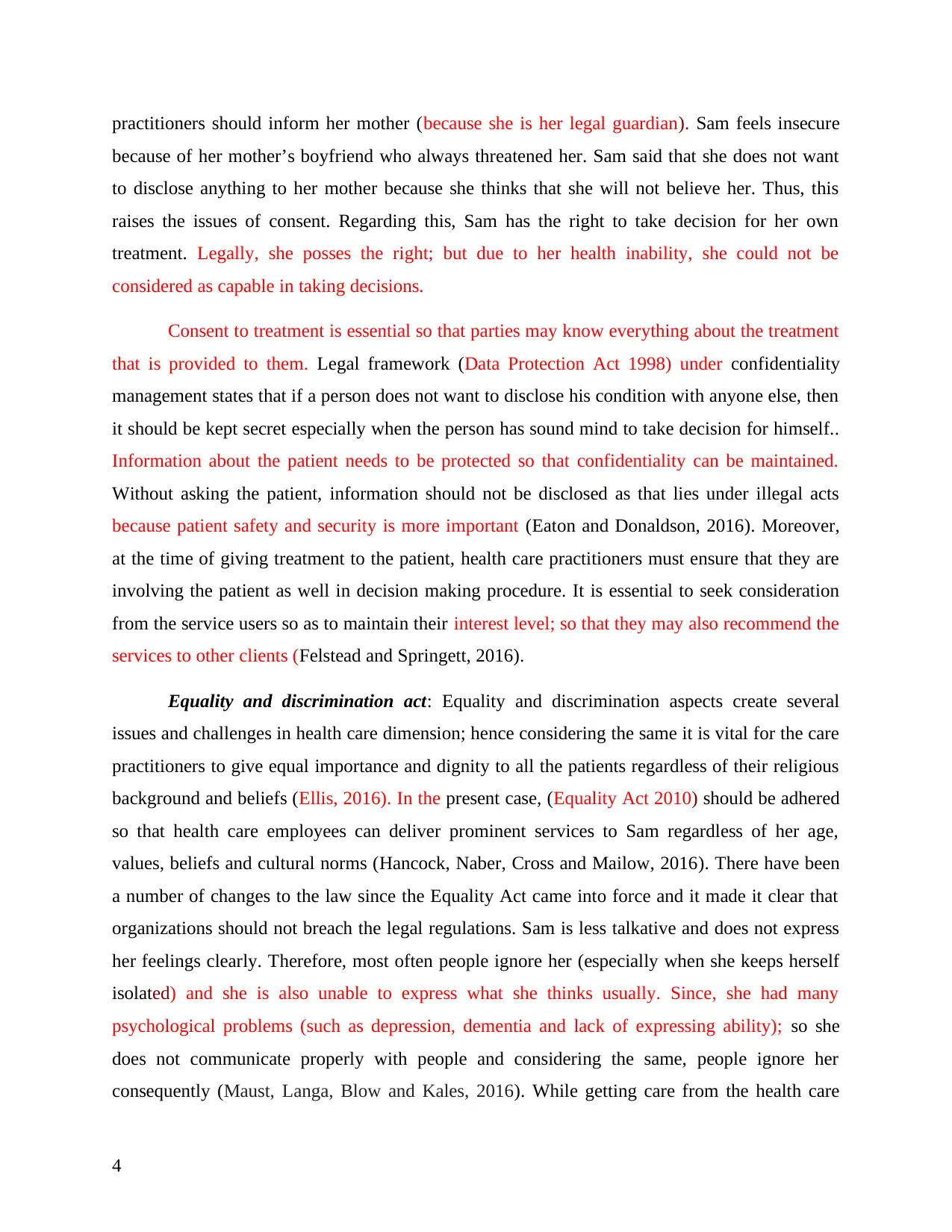
practitioners should inform her mother (because she is her legal guardian). Sam feels insecure
because of her mother’s boyfriend who always threatened her. Sam said that she does not want
to disclose anything to her mother because she thinks that she will not believe her. Thus, this
raises the issues of consent. Regarding this, Sam has the right to take decision for her own
treatment. Legally, she posses the right; but due to her health inability, she could not be
considered as capable in taking decisions.
Consent to treatment is essential so that parties may know everything about the treatment
that is provided to them. Legal framework (Data Protection Act 1998) under confidentiality
management states that if a person does not want to disclose his condition with anyone else, then
it should be kept secret especially when the person has sound mind to take decision for himself..
Information about the patient needs to be protected so that confidentiality can be maintained.
Without asking the patient, information should not be disclosed as that lies under illegal acts
because patient safety and security is more important (Eaton and Donaldson, 2016). Moreover,
at the time of giving treatment to the patient, health care practitioners must ensure that they are
involving the patient as well in decision making procedure. It is essential to seek consideration
from the service users so as to maintain their interest level; so that they may also recommend the
services to other clients (Felstead and Springett, 2016).
Equality and discrimination act: Equality and discrimination aspects create several
issues and challenges in health care dimension; hence considering the same it is vital for the care
practitioners to give equal importance and dignity to all the patients regardless of their religious
background and beliefs (Ellis, 2016). In the present case, (Equality Act 2010) should be adhered
so that health care employees can deliver prominent services to Sam regardless of her age,
values, beliefs and cultural norms (Hancock, Naber, Cross and Mailow, 2016). There have been
a number of changes to the law since the Equality Act came into force and it made it clear that
organizations should not breach the legal regulations. Sam is less talkative and does not express
her feelings clearly. Therefore, most often people ignore her (especially when she keeps herself
isolated) and she is also unable to express what she thinks usually. Since, she had many
psychological problems (such as depression, dementia and lack of expressing ability); so she
does not communicate properly with people and considering the same, people ignore her
consequently (Maust, Langa, Blow and Kales, 2016). While getting care from the health care
4
because of her mother’s boyfriend who always threatened her. Sam said that she does not want
to disclose anything to her mother because she thinks that she will not believe her. Thus, this
raises the issues of consent. Regarding this, Sam has the right to take decision for her own
treatment. Legally, she posses the right; but due to her health inability, she could not be
considered as capable in taking decisions.
Consent to treatment is essential so that parties may know everything about the treatment
that is provided to them. Legal framework (Data Protection Act 1998) under confidentiality
management states that if a person does not want to disclose his condition with anyone else, then
it should be kept secret especially when the person has sound mind to take decision for himself..
Information about the patient needs to be protected so that confidentiality can be maintained.
Without asking the patient, information should not be disclosed as that lies under illegal acts
because patient safety and security is more important (Eaton and Donaldson, 2016). Moreover,
at the time of giving treatment to the patient, health care practitioners must ensure that they are
involving the patient as well in decision making procedure. It is essential to seek consideration
from the service users so as to maintain their interest level; so that they may also recommend the
services to other clients (Felstead and Springett, 2016).
Equality and discrimination act: Equality and discrimination aspects create several
issues and challenges in health care dimension; hence considering the same it is vital for the care
practitioners to give equal importance and dignity to all the patients regardless of their religious
background and beliefs (Ellis, 2016). In the present case, (Equality Act 2010) should be adhered
so that health care employees can deliver prominent services to Sam regardless of her age,
values, beliefs and cultural norms (Hancock, Naber, Cross and Mailow, 2016). There have been
a number of changes to the law since the Equality Act came into force and it made it clear that
organizations should not breach the legal regulations. Sam is less talkative and does not express
her feelings clearly. Therefore, most often people ignore her (especially when she keeps herself
isolated) and she is also unable to express what she thinks usually. Since, she had many
psychological problems (such as depression, dementia and lack of expressing ability); so she
does not communicate properly with people and considering the same, people ignore her
consequently (Maust, Langa, Blow and Kales, 2016). While getting care from the health care
4
Secure Best Marks with AI Grader
Need help grading? Try our AI Grader for instant feedback on your assignments.
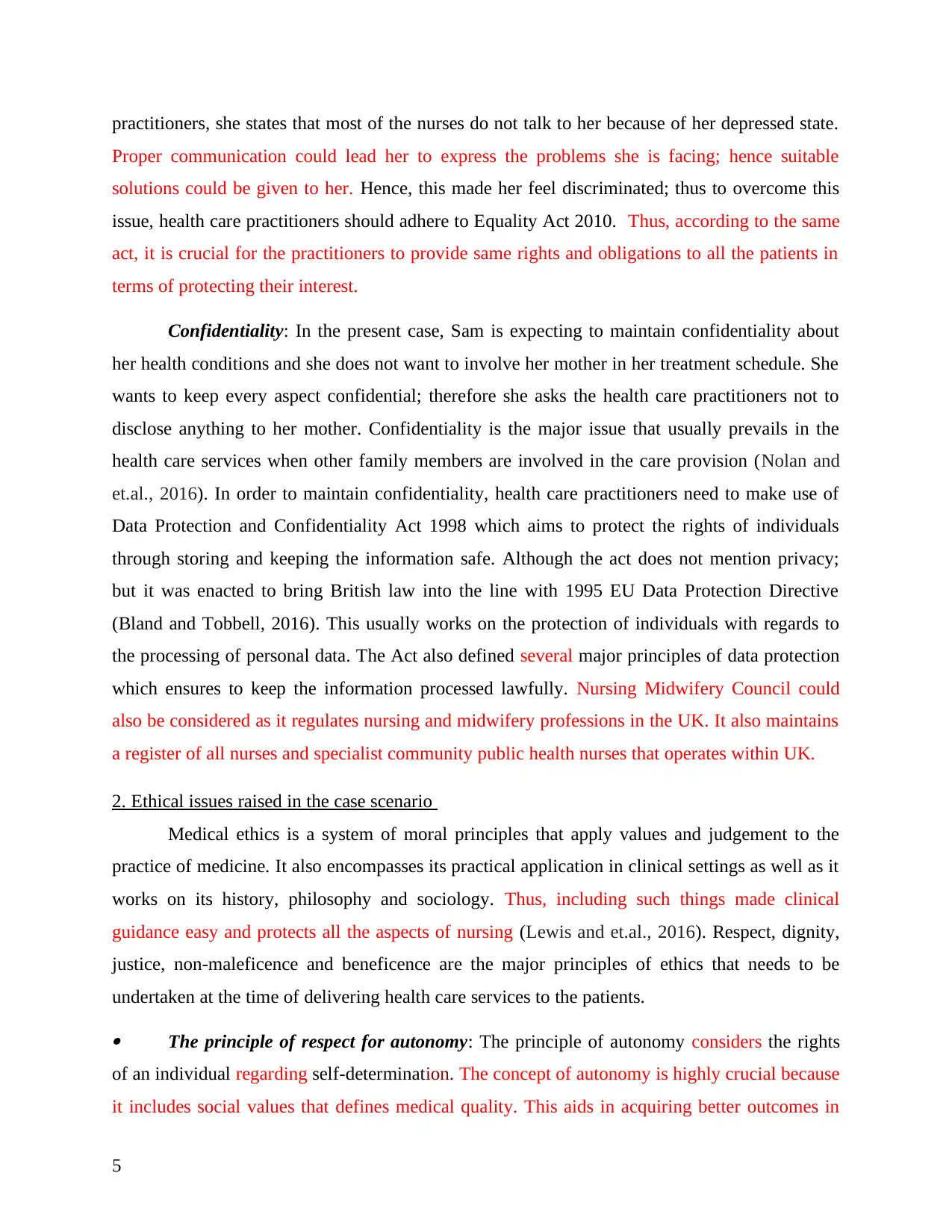
practitioners, she states that most of the nurses do not talk to her because of her depressed state.
Proper communication could lead her to express the problems she is facing; hence suitable
solutions could be given to her. Hence, this made her feel discriminated; thus to overcome this
issue, health care practitioners should adhere to Equality Act 2010. Thus, according to the same
act, it is crucial for the practitioners to provide same rights and obligations to all the patients in
terms of protecting their interest.
Confidentiality: In the present case, Sam is expecting to maintain confidentiality about
her health conditions and she does not want to involve her mother in her treatment schedule. She
wants to keep every aspect confidential; therefore she asks the health care practitioners not to
disclose anything to her mother. Confidentiality is the major issue that usually prevails in the
health care services when other family members are involved in the care provision (Nolan and
et.al., 2016). In order to maintain confidentiality, health care practitioners need to make use of
Data Protection and Confidentiality Act 1998 which aims to protect the rights of individuals
through storing and keeping the information safe. Although the act does not mention privacy;
but it was enacted to bring British law into the line with 1995 EU Data Protection Directive
(Bland and Tobbell, 2016). This usually works on the protection of individuals with regards to
the processing of personal data. The Act also defined several major principles of data protection
which ensures to keep the information processed lawfully. Nursing Midwifery Council could
also be considered as it regulates nursing and midwifery professions in the UK. It also maintains
a register of all nurses and specialist community public health nurses that operates within UK.
2. Ethical issues raised in the case scenario
Medical ethics is a system of moral principles that apply values and judgement to the
practice of medicine. It also encompasses its practical application in clinical settings as well as it
works on its history, philosophy and sociology. Thus, including such things made clinical
guidance easy and protects all the aspects of nursing (Lewis and et.al., 2016). Respect, dignity,
justice, non-maleficence and beneficence are the major principles of ethics that needs to be
undertaken at the time of delivering health care services to the patients.
The principle of respect for autonomy: The principle of autonomy considers the rights
of an individual regarding self-determination. The concept of autonomy is highly crucial because
it includes social values that defines medical quality. This aids in acquiring better outcomes in
5
Proper communication could lead her to express the problems she is facing; hence suitable
solutions could be given to her. Hence, this made her feel discriminated; thus to overcome this
issue, health care practitioners should adhere to Equality Act 2010. Thus, according to the same
act, it is crucial for the practitioners to provide same rights and obligations to all the patients in
terms of protecting their interest.
Confidentiality: In the present case, Sam is expecting to maintain confidentiality about
her health conditions and she does not want to involve her mother in her treatment schedule. She
wants to keep every aspect confidential; therefore she asks the health care practitioners not to
disclose anything to her mother. Confidentiality is the major issue that usually prevails in the
health care services when other family members are involved in the care provision (Nolan and
et.al., 2016). In order to maintain confidentiality, health care practitioners need to make use of
Data Protection and Confidentiality Act 1998 which aims to protect the rights of individuals
through storing and keeping the information safe. Although the act does not mention privacy;
but it was enacted to bring British law into the line with 1995 EU Data Protection Directive
(Bland and Tobbell, 2016). This usually works on the protection of individuals with regards to
the processing of personal data. The Act also defined several major principles of data protection
which ensures to keep the information processed lawfully. Nursing Midwifery Council could
also be considered as it regulates nursing and midwifery professions in the UK. It also maintains
a register of all nurses and specialist community public health nurses that operates within UK.
2. Ethical issues raised in the case scenario
Medical ethics is a system of moral principles that apply values and judgement to the
practice of medicine. It also encompasses its practical application in clinical settings as well as it
works on its history, philosophy and sociology. Thus, including such things made clinical
guidance easy and protects all the aspects of nursing (Lewis and et.al., 2016). Respect, dignity,
justice, non-maleficence and beneficence are the major principles of ethics that needs to be
undertaken at the time of delivering health care services to the patients.
The principle of respect for autonomy: The principle of autonomy considers the rights
of an individual regarding self-determination. The concept of autonomy is highly crucial because
it includes social values that defines medical quality. This aids in acquiring better outcomes in
5
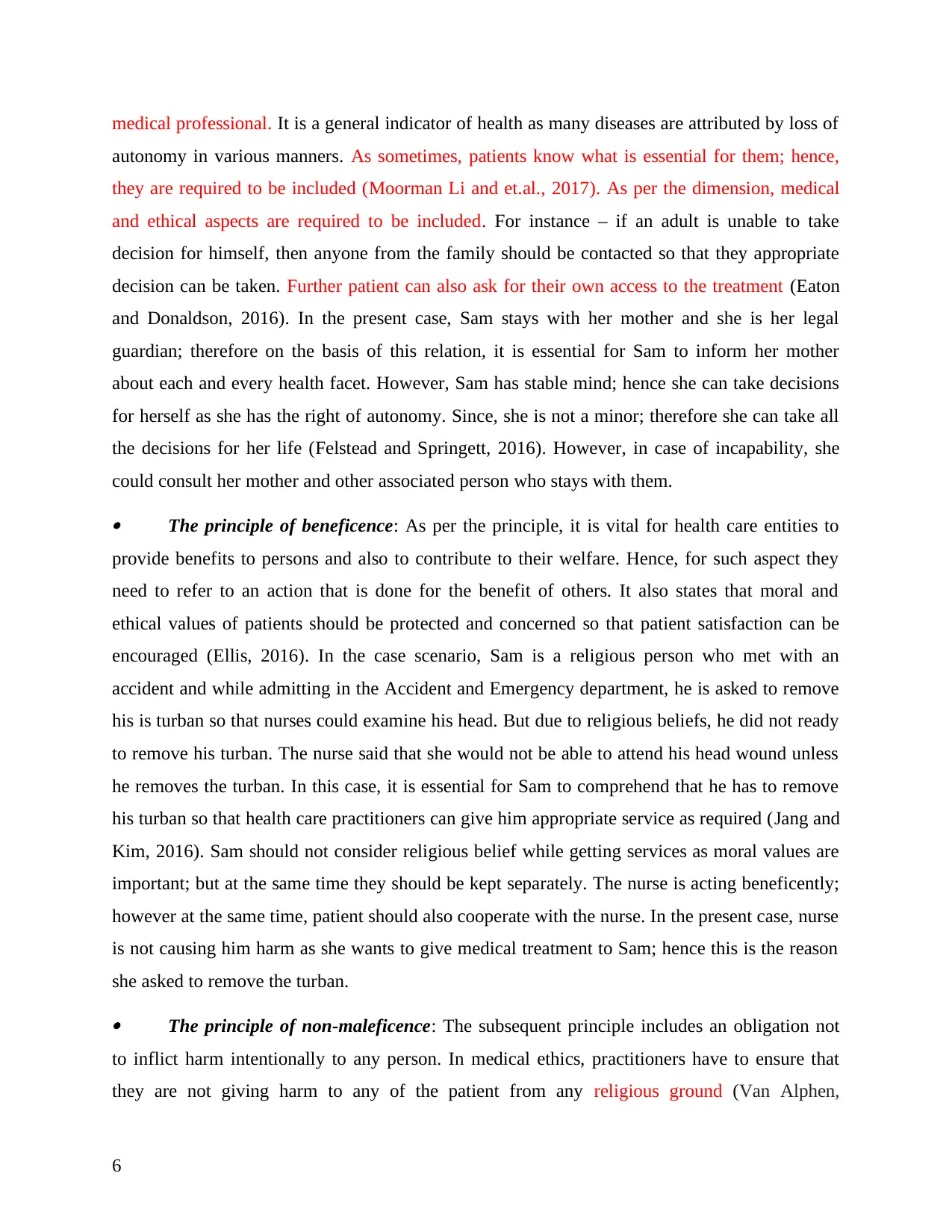
medical professional. It is a general indicator of health as many diseases are attributed by loss of
autonomy in various manners. As sometimes, patients know what is essential for them; hence,
they are required to be included (Moorman Li and et.al., 2017). As per the dimension, medical
and ethical aspects are required to be included. For instance – if an adult is unable to take
decision for himself, then anyone from the family should be contacted so that they appropriate
decision can be taken. Further patient can also ask for their own access to the treatment (Eaton
and Donaldson, 2016). In the present case, Sam stays with her mother and she is her legal
guardian; therefore on the basis of this relation, it is essential for Sam to inform her mother
about each and every health facet. However, Sam has stable mind; hence she can take decisions
for herself as she has the right of autonomy. Since, she is not a minor; therefore she can take all
the decisions for her life (Felstead and Springett, 2016). However, in case of incapability, she
could consult her mother and other associated person who stays with them.
The principle of beneficence: As per the principle, it is vital for health care entities to
provide benefits to persons and also to contribute to their welfare. Hence, for such aspect they
need to refer to an action that is done for the benefit of others. It also states that moral and
ethical values of patients should be protected and concerned so that patient satisfaction can be
encouraged (Ellis, 2016). In the case scenario, Sam is a religious person who met with an
accident and while admitting in the Accident and Emergency department, he is asked to remove
his is turban so that nurses could examine his head. But due to religious beliefs, he did not ready
to remove his turban. The nurse said that she would not be able to attend his head wound unless
he removes the turban. In this case, it is essential for Sam to comprehend that he has to remove
his turban so that health care practitioners can give him appropriate service as required (Jang and
Kim, 2016). Sam should not consider religious belief while getting services as moral values are
important; but at the same time they should be kept separately. The nurse is acting beneficently;
however at the same time, patient should also cooperate with the nurse. In the present case, nurse
is not causing him harm as she wants to give medical treatment to Sam; hence this is the reason
she asked to remove the turban.
The principle of non-maleficence: The subsequent principle includes an obligation not
to inflict harm intentionally to any person. In medical ethics, practitioners have to ensure that
they are not giving harm to any of the patient from any religious ground (Van Alphen,
6
autonomy in various manners. As sometimes, patients know what is essential for them; hence,
they are required to be included (Moorman Li and et.al., 2017). As per the dimension, medical
and ethical aspects are required to be included. For instance – if an adult is unable to take
decision for himself, then anyone from the family should be contacted so that they appropriate
decision can be taken. Further patient can also ask for their own access to the treatment (Eaton
and Donaldson, 2016). In the present case, Sam stays with her mother and she is her legal
guardian; therefore on the basis of this relation, it is essential for Sam to inform her mother
about each and every health facet. However, Sam has stable mind; hence she can take decisions
for herself as she has the right of autonomy. Since, she is not a minor; therefore she can take all
the decisions for her life (Felstead and Springett, 2016). However, in case of incapability, she
could consult her mother and other associated person who stays with them.
The principle of beneficence: As per the principle, it is vital for health care entities to
provide benefits to persons and also to contribute to their welfare. Hence, for such aspect they
need to refer to an action that is done for the benefit of others. It also states that moral and
ethical values of patients should be protected and concerned so that patient satisfaction can be
encouraged (Ellis, 2016). In the case scenario, Sam is a religious person who met with an
accident and while admitting in the Accident and Emergency department, he is asked to remove
his is turban so that nurses could examine his head. But due to religious beliefs, he did not ready
to remove his turban. The nurse said that she would not be able to attend his head wound unless
he removes the turban. In this case, it is essential for Sam to comprehend that he has to remove
his turban so that health care practitioners can give him appropriate service as required (Jang and
Kim, 2016). Sam should not consider religious belief while getting services as moral values are
important; but at the same time they should be kept separately. The nurse is acting beneficently;
however at the same time, patient should also cooperate with the nurse. In the present case, nurse
is not causing him harm as she wants to give medical treatment to Sam; hence this is the reason
she asked to remove the turban.
The principle of non-maleficence: The subsequent principle includes an obligation not
to inflict harm intentionally to any person. In medical ethics, practitioners have to ensure that
they are not giving harm to any of the patient from any religious ground (Van Alphen,
6
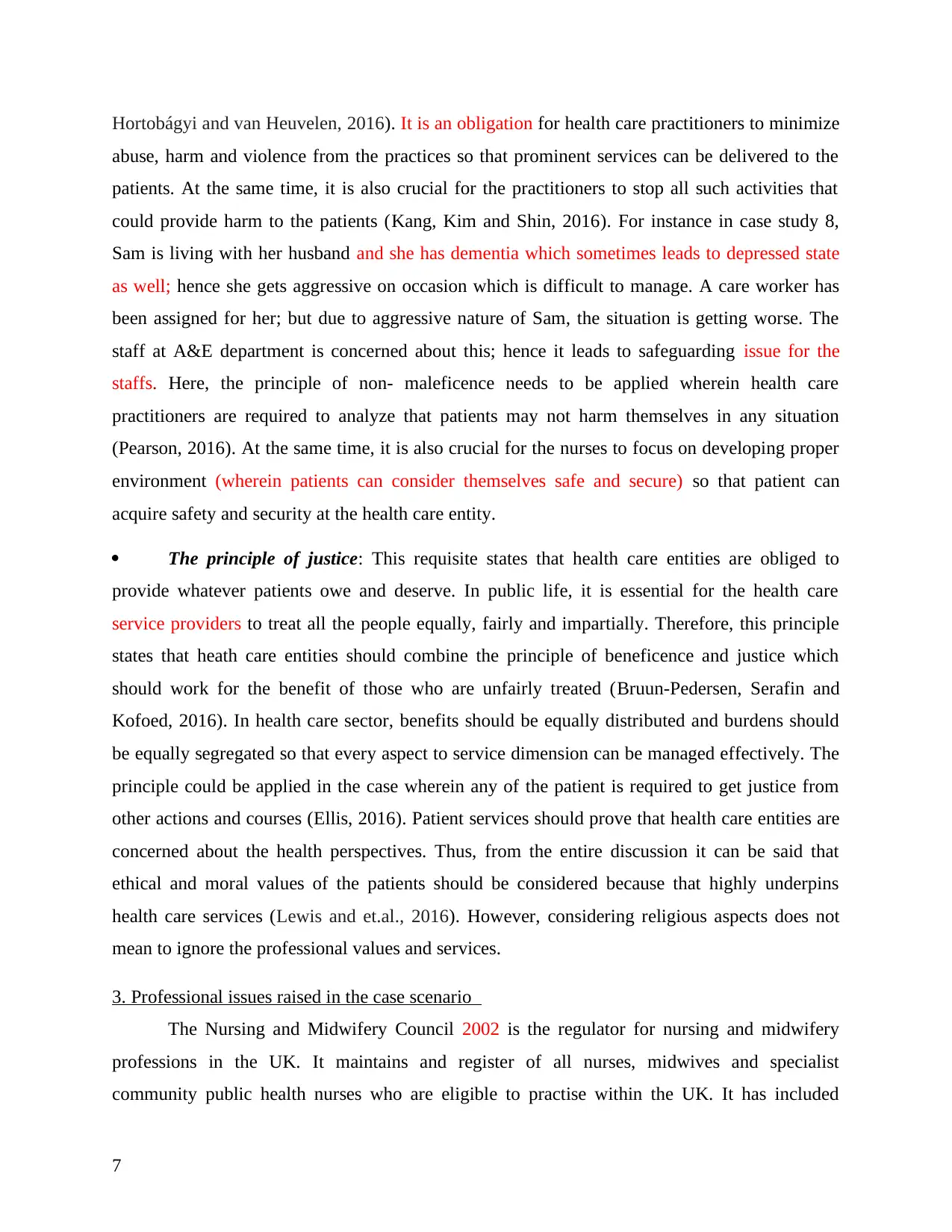
Hortobágyi and van Heuvelen, 2016). It is an obligation for health care practitioners to minimize
abuse, harm and violence from the practices so that prominent services can be delivered to the
patients. At the same time, it is also crucial for the practitioners to stop all such activities that
could provide harm to the patients (Kang, Kim and Shin, 2016). For instance in case study 8,
Sam is living with her husband and she has dementia which sometimes leads to depressed state
as well; hence she gets aggressive on occasion which is difficult to manage. A care worker has
been assigned for her; but due to aggressive nature of Sam, the situation is getting worse. The
staff at A&E department is concerned about this; hence it leads to safeguarding issue for the
staffs. Here, the principle of non- maleficence needs to be applied wherein health care
practitioners are required to analyze that patients may not harm themselves in any situation
(Pearson, 2016). At the same time, it is also crucial for the nurses to focus on developing proper
environment (wherein patients can consider themselves safe and secure) so that patient can
acquire safety and security at the health care entity.
The principle of justice: This requisite states that health care entities are obliged to
provide whatever patients owe and deserve. In public life, it is essential for the health care
service providers to treat all the people equally, fairly and impartially. Therefore, this principle
states that heath care entities should combine the principle of beneficence and justice which
should work for the benefit of those who are unfairly treated (Bruun-Pedersen, Serafin and
Kofoed, 2016). In health care sector, benefits should be equally distributed and burdens should
be equally segregated so that every aspect to service dimension can be managed effectively. The
principle could be applied in the case wherein any of the patient is required to get justice from
other actions and courses (Ellis, 2016). Patient services should prove that health care entities are
concerned about the health perspectives. Thus, from the entire discussion it can be said that
ethical and moral values of the patients should be considered because that highly underpins
health care services (Lewis and et.al., 2016). However, considering religious aspects does not
mean to ignore the professional values and services.
3. Professional issues raised in the case scenario
The Nursing and Midwifery Council 2002 is the regulator for nursing and midwifery
professions in the UK. It maintains and register of all nurses, midwives and specialist
community public health nurses who are eligible to practise within the UK. It has included
7
abuse, harm and violence from the practices so that prominent services can be delivered to the
patients. At the same time, it is also crucial for the practitioners to stop all such activities that
could provide harm to the patients (Kang, Kim and Shin, 2016). For instance in case study 8,
Sam is living with her husband and she has dementia which sometimes leads to depressed state
as well; hence she gets aggressive on occasion which is difficult to manage. A care worker has
been assigned for her; but due to aggressive nature of Sam, the situation is getting worse. The
staff at A&E department is concerned about this; hence it leads to safeguarding issue for the
staffs. Here, the principle of non- maleficence needs to be applied wherein health care
practitioners are required to analyze that patients may not harm themselves in any situation
(Pearson, 2016). At the same time, it is also crucial for the nurses to focus on developing proper
environment (wherein patients can consider themselves safe and secure) so that patient can
acquire safety and security at the health care entity.
The principle of justice: This requisite states that health care entities are obliged to
provide whatever patients owe and deserve. In public life, it is essential for the health care
service providers to treat all the people equally, fairly and impartially. Therefore, this principle
states that heath care entities should combine the principle of beneficence and justice which
should work for the benefit of those who are unfairly treated (Bruun-Pedersen, Serafin and
Kofoed, 2016). In health care sector, benefits should be equally distributed and burdens should
be equally segregated so that every aspect to service dimension can be managed effectively. The
principle could be applied in the case wherein any of the patient is required to get justice from
other actions and courses (Ellis, 2016). Patient services should prove that health care entities are
concerned about the health perspectives. Thus, from the entire discussion it can be said that
ethical and moral values of the patients should be considered because that highly underpins
health care services (Lewis and et.al., 2016). However, considering religious aspects does not
mean to ignore the professional values and services.
3. Professional issues raised in the case scenario
The Nursing and Midwifery Council 2002 is the regulator for nursing and midwifery
professions in the UK. It maintains and register of all nurses, midwives and specialist
community public health nurses who are eligible to practise within the UK. It has included
7
Paraphrase This Document
Need a fresh take? Get an instant paraphrase of this document with our AI Paraphraser
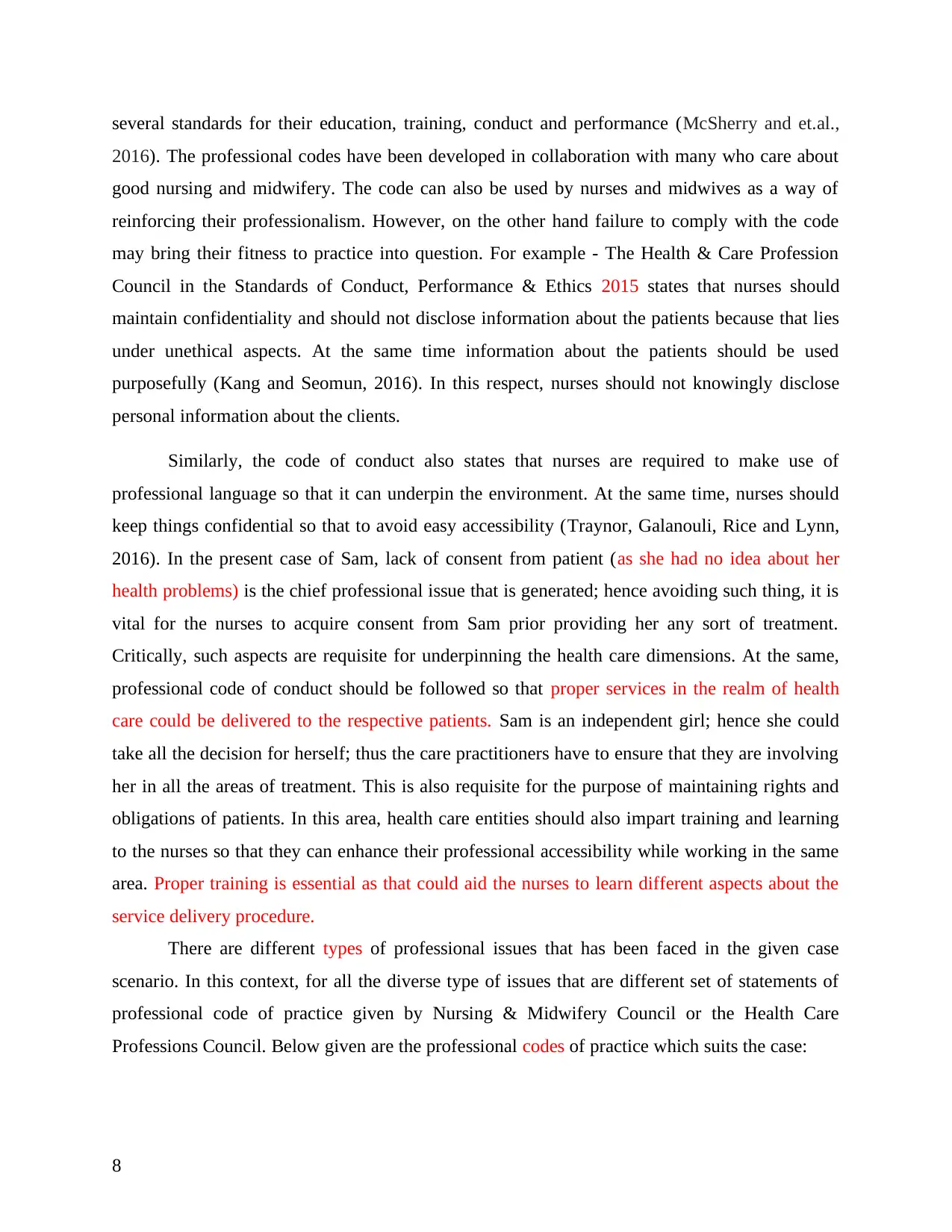
several standards for their education, training, conduct and performance (McSherry and et.al.,
2016). The professional codes have been developed in collaboration with many who care about
good nursing and midwifery. The code can also be used by nurses and midwives as a way of
reinforcing their professionalism. However, on the other hand failure to comply with the code
may bring their fitness to practice into question. For example - The Health & Care Profession
Council in the Standards of Conduct, Performance & Ethics 2015 states that nurses should
maintain confidentiality and should not disclose information about the patients because that lies
under unethical aspects. At the same time information about the patients should be used
purposefully (Kang and Seomun, 2016). In this respect, nurses should not knowingly disclose
personal information about the clients.
Similarly, the code of conduct also states that nurses are required to make use of
professional language so that it can underpin the environment. At the same time, nurses should
keep things confidential so that to avoid easy accessibility (Traynor, Galanouli, Rice and Lynn,
2016). In the present case of Sam, lack of consent from patient (as she had no idea about her
health problems) is the chief professional issue that is generated; hence avoiding such thing, it is
vital for the nurses to acquire consent from Sam prior providing her any sort of treatment.
Critically, such aspects are requisite for underpinning the health care dimensions. At the same,
professional code of conduct should be followed so that proper services in the realm of health
care could be delivered to the respective patients. Sam is an independent girl; hence she could
take all the decision for herself; thus the care practitioners have to ensure that they are involving
her in all the areas of treatment. This is also requisite for the purpose of maintaining rights and
obligations of patients. In this area, health care entities should also impart training and learning
to the nurses so that they can enhance their professional accessibility while working in the same
area. Proper training is essential as that could aid the nurses to learn different aspects about the
service delivery procedure.
There are different types of professional issues that has been faced in the given case
scenario. In this context, for all the diverse type of issues that are different set of statements of
professional code of practice given by Nursing & Midwifery Council or the Health Care
Professions Council. Below given are the professional codes of practice which suits the case:
8
2016). The professional codes have been developed in collaboration with many who care about
good nursing and midwifery. The code can also be used by nurses and midwives as a way of
reinforcing their professionalism. However, on the other hand failure to comply with the code
may bring their fitness to practice into question. For example - The Health & Care Profession
Council in the Standards of Conduct, Performance & Ethics 2015 states that nurses should
maintain confidentiality and should not disclose information about the patients because that lies
under unethical aspects. At the same time information about the patients should be used
purposefully (Kang and Seomun, 2016). In this respect, nurses should not knowingly disclose
personal information about the clients.
Similarly, the code of conduct also states that nurses are required to make use of
professional language so that it can underpin the environment. At the same time, nurses should
keep things confidential so that to avoid easy accessibility (Traynor, Galanouli, Rice and Lynn,
2016). In the present case of Sam, lack of consent from patient (as she had no idea about her
health problems) is the chief professional issue that is generated; hence avoiding such thing, it is
vital for the nurses to acquire consent from Sam prior providing her any sort of treatment.
Critically, such aspects are requisite for underpinning the health care dimensions. At the same,
professional code of conduct should be followed so that proper services in the realm of health
care could be delivered to the respective patients. Sam is an independent girl; hence she could
take all the decision for herself; thus the care practitioners have to ensure that they are involving
her in all the areas of treatment. This is also requisite for the purpose of maintaining rights and
obligations of patients. In this area, health care entities should also impart training and learning
to the nurses so that they can enhance their professional accessibility while working in the same
area. Proper training is essential as that could aid the nurses to learn different aspects about the
service delivery procedure.
There are different types of professional issues that has been faced in the given case
scenario. In this context, for all the diverse type of issues that are different set of statements of
professional code of practice given by Nursing & Midwifery Council or the Health Care
Professions Council. Below given are the professional codes of practice which suits the case:
8
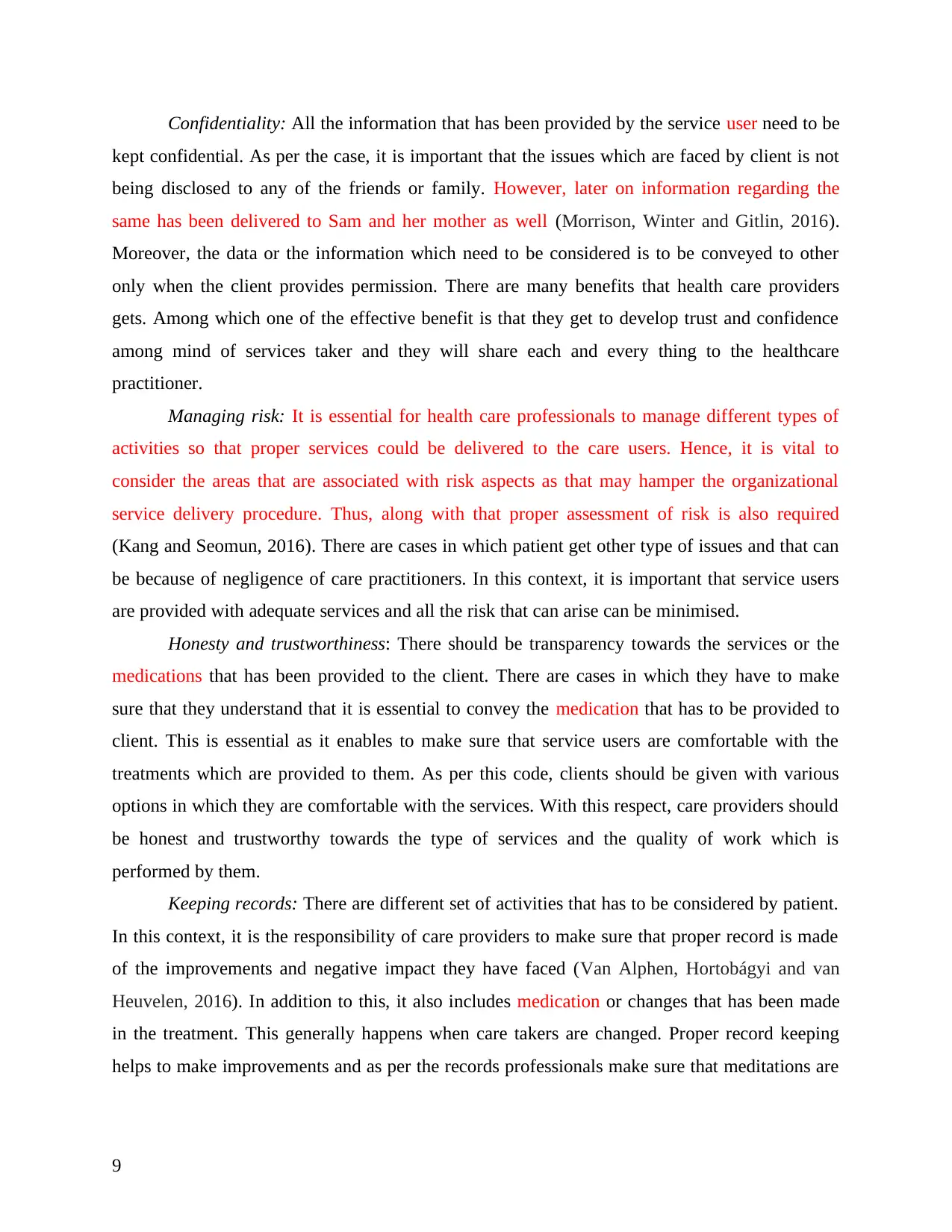
Confidentiality: All the information that has been provided by the service user need to be
kept confidential. As per the case, it is important that the issues which are faced by client is not
being disclosed to any of the friends or family. However, later on information regarding the
same has been delivered to Sam and her mother as well (Morrison, Winter and Gitlin, 2016).
Moreover, the data or the information which need to be considered is to be conveyed to other
only when the client provides permission. There are many benefits that health care providers
gets. Among which one of the effective benefit is that they get to develop trust and confidence
among mind of services taker and they will share each and every thing to the healthcare
practitioner.
Managing risk: It is essential for health care professionals to manage different types of
activities so that proper services could be delivered to the care users. Hence, it is vital to
consider the areas that are associated with risk aspects as that may hamper the organizational
service delivery procedure. Thus, along with that proper assessment of risk is also required
(Kang and Seomun, 2016). There are cases in which patient get other type of issues and that can
be because of negligence of care practitioners. In this context, it is important that service users
are provided with adequate services and all the risk that can arise can be minimised.
Honesty and trustworthiness: There should be transparency towards the services or the
medications that has been provided to the client. There are cases in which they have to make
sure that they understand that it is essential to convey the medication that has to be provided to
client. This is essential as it enables to make sure that service users are comfortable with the
treatments which are provided to them. As per this code, clients should be given with various
options in which they are comfortable with the services. With this respect, care providers should
be honest and trustworthy towards the type of services and the quality of work which is
performed by them.
Keeping records: There are different set of activities that has to be considered by patient.
In this context, it is the responsibility of care providers to make sure that proper record is made
of the improvements and negative impact they have faced (Van Alphen, Hortobágyi and van
Heuvelen, 2016). In addition to this, it also includes medication or changes that has been made
in the treatment. This generally happens when care takers are changed. Proper record keeping
helps to make improvements and as per the records professionals make sure that meditations are
9
kept confidential. As per the case, it is important that the issues which are faced by client is not
being disclosed to any of the friends or family. However, later on information regarding the
same has been delivered to Sam and her mother as well (Morrison, Winter and Gitlin, 2016).
Moreover, the data or the information which need to be considered is to be conveyed to other
only when the client provides permission. There are many benefits that health care providers
gets. Among which one of the effective benefit is that they get to develop trust and confidence
among mind of services taker and they will share each and every thing to the healthcare
practitioner.
Managing risk: It is essential for health care professionals to manage different types of
activities so that proper services could be delivered to the care users. Hence, it is vital to
consider the areas that are associated with risk aspects as that may hamper the organizational
service delivery procedure. Thus, along with that proper assessment of risk is also required
(Kang and Seomun, 2016). There are cases in which patient get other type of issues and that can
be because of negligence of care practitioners. In this context, it is important that service users
are provided with adequate services and all the risk that can arise can be minimised.
Honesty and trustworthiness: There should be transparency towards the services or the
medications that has been provided to the client. There are cases in which they have to make
sure that they understand that it is essential to convey the medication that has to be provided to
client. This is essential as it enables to make sure that service users are comfortable with the
treatments which are provided to them. As per this code, clients should be given with various
options in which they are comfortable with the services. With this respect, care providers should
be honest and trustworthy towards the type of services and the quality of work which is
performed by them.
Keeping records: There are different set of activities that has to be considered by patient.
In this context, it is the responsibility of care providers to make sure that proper record is made
of the improvements and negative impact they have faced (Van Alphen, Hortobágyi and van
Heuvelen, 2016). In addition to this, it also includes medication or changes that has been made
in the treatment. This generally happens when care takers are changed. Proper record keeping
helps to make improvements and as per the records professionals make sure that meditations are
9
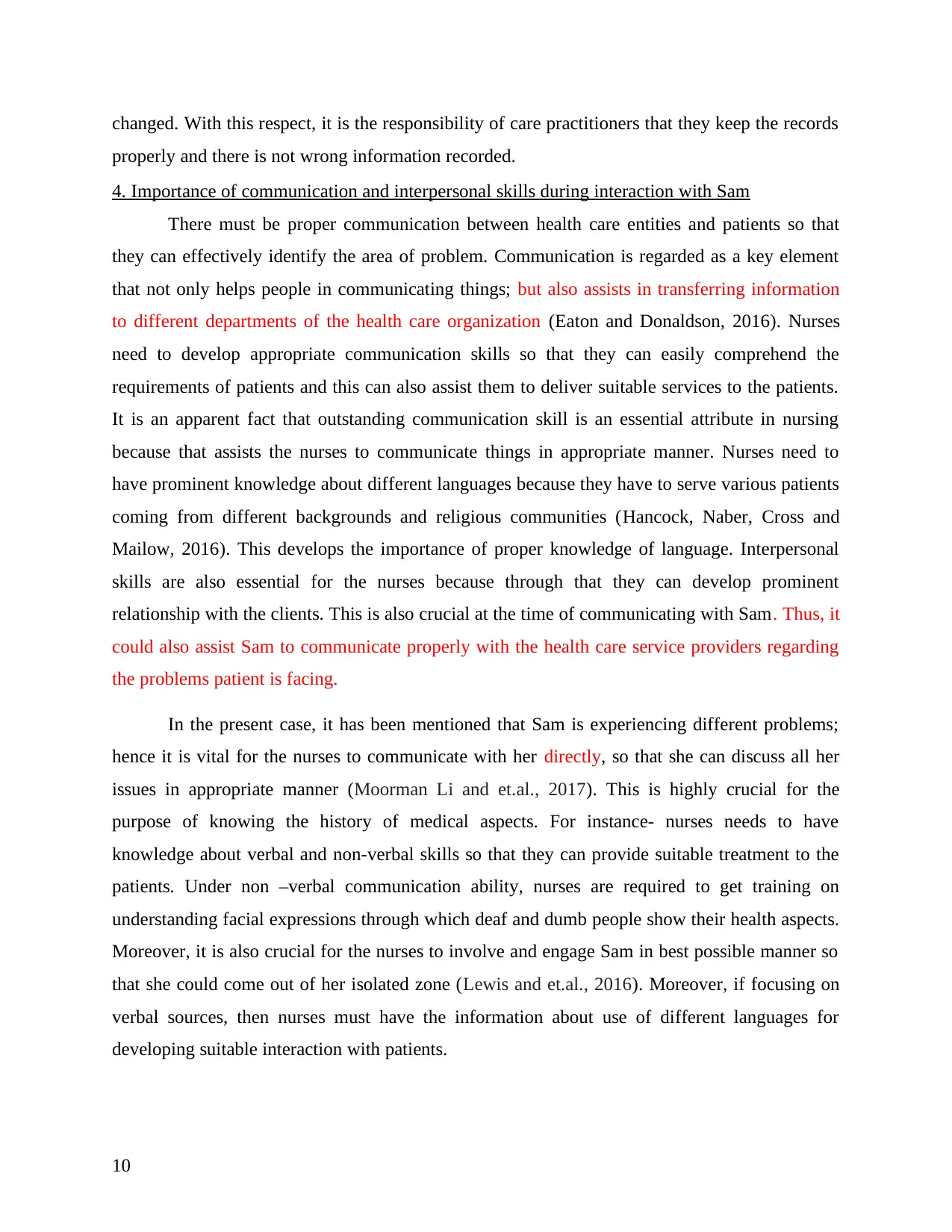
changed. With this respect, it is the responsibility of care practitioners that they keep the records
properly and there is not wrong information recorded.
4. Importance of communication and interpersonal skills during interaction with Sam
There must be proper communication between health care entities and patients so that
they can effectively identify the area of problem. Communication is regarded as a key element
that not only helps people in communicating things; but also assists in transferring information
to different departments of the health care organization (Eaton and Donaldson, 2016). Nurses
need to develop appropriate communication skills so that they can easily comprehend the
requirements of patients and this can also assist them to deliver suitable services to the patients.
It is an apparent fact that outstanding communication skill is an essential attribute in nursing
because that assists the nurses to communicate things in appropriate manner. Nurses need to
have prominent knowledge about different languages because they have to serve various patients
coming from different backgrounds and religious communities (Hancock, Naber, Cross and
Mailow, 2016). This develops the importance of proper knowledge of language. Interpersonal
skills are also essential for the nurses because through that they can develop prominent
relationship with the clients. This is also crucial at the time of communicating with Sam. Thus, it
could also assist Sam to communicate properly with the health care service providers regarding
the problems patient is facing.
In the present case, it has been mentioned that Sam is experiencing different problems;
hence it is vital for the nurses to communicate with her directly, so that she can discuss all her
issues in appropriate manner (Moorman Li and et.al., 2017). This is highly crucial for the
purpose of knowing the history of medical aspects. For instance- nurses needs to have
knowledge about verbal and non-verbal skills so that they can provide suitable treatment to the
patients. Under non –verbal communication ability, nurses are required to get training on
understanding facial expressions through which deaf and dumb people show their health aspects.
Moreover, it is also crucial for the nurses to involve and engage Sam in best possible manner so
that she could come out of her isolated zone (Lewis and et.al., 2016). Moreover, if focusing on
verbal sources, then nurses must have the information about use of different languages for
developing suitable interaction with patients.
10
properly and there is not wrong information recorded.
4. Importance of communication and interpersonal skills during interaction with Sam
There must be proper communication between health care entities and patients so that
they can effectively identify the area of problem. Communication is regarded as a key element
that not only helps people in communicating things; but also assists in transferring information
to different departments of the health care organization (Eaton and Donaldson, 2016). Nurses
need to develop appropriate communication skills so that they can easily comprehend the
requirements of patients and this can also assist them to deliver suitable services to the patients.
It is an apparent fact that outstanding communication skill is an essential attribute in nursing
because that assists the nurses to communicate things in appropriate manner. Nurses need to
have prominent knowledge about different languages because they have to serve various patients
coming from different backgrounds and religious communities (Hancock, Naber, Cross and
Mailow, 2016). This develops the importance of proper knowledge of language. Interpersonal
skills are also essential for the nurses because through that they can develop prominent
relationship with the clients. This is also crucial at the time of communicating with Sam. Thus, it
could also assist Sam to communicate properly with the health care service providers regarding
the problems patient is facing.
In the present case, it has been mentioned that Sam is experiencing different problems;
hence it is vital for the nurses to communicate with her directly, so that she can discuss all her
issues in appropriate manner (Moorman Li and et.al., 2017). This is highly crucial for the
purpose of knowing the history of medical aspects. For instance- nurses needs to have
knowledge about verbal and non-verbal skills so that they can provide suitable treatment to the
patients. Under non –verbal communication ability, nurses are required to get training on
understanding facial expressions through which deaf and dumb people show their health aspects.
Moreover, it is also crucial for the nurses to involve and engage Sam in best possible manner so
that she could come out of her isolated zone (Lewis and et.al., 2016). Moreover, if focusing on
verbal sources, then nurses must have the information about use of different languages for
developing suitable interaction with patients.
10
Secure Best Marks with AI Grader
Need help grading? Try our AI Grader for instant feedback on your assignments.
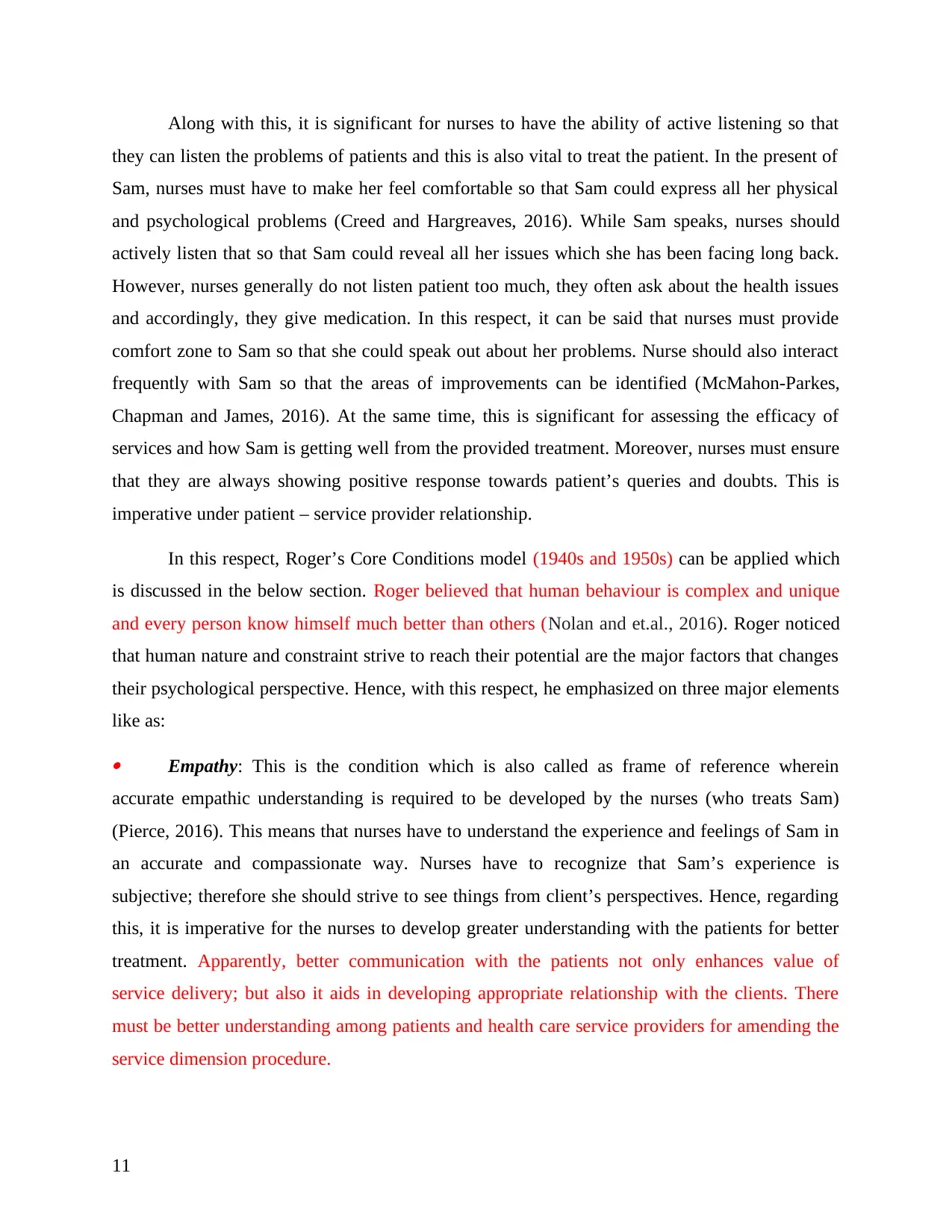
Along with this, it is significant for nurses to have the ability of active listening so that
they can listen the problems of patients and this is also vital to treat the patient. In the present of
Sam, nurses must have to make her feel comfortable so that Sam could express all her physical
and psychological problems (Creed and Hargreaves, 2016). While Sam speaks, nurses should
actively listen that so that Sam could reveal all her issues which she has been facing long back.
However, nurses generally do not listen patient too much, they often ask about the health issues
and accordingly, they give medication. In this respect, it can be said that nurses must provide
comfort zone to Sam so that she could speak out about her problems. Nurse should also interact
frequently with Sam so that the areas of improvements can be identified (McMahon-Parkes,
Chapman and James, 2016). At the same time, this is significant for assessing the efficacy of
services and how Sam is getting well from the provided treatment. Moreover, nurses must ensure
that they are always showing positive response towards patient’s queries and doubts. This is
imperative under patient – service provider relationship.
In this respect, Roger’s Core Conditions model (1940s and 1950s) can be applied which
is discussed in the below section. Roger believed that human behaviour is complex and unique
and every person know himself much better than others (Nolan and et.al., 2016). Roger noticed
that human nature and constraint strive to reach their potential are the major factors that changes
their psychological perspective. Hence, with this respect, he emphasized on three major elements
like as:
Empathy: This is the condition which is also called as frame of reference wherein
accurate empathic understanding is required to be developed by the nurses (who treats Sam)
(Pierce, 2016). This means that nurses have to understand the experience and feelings of Sam in
an accurate and compassionate way. Nurses have to recognize that Sam’s experience is
subjective; therefore she should strive to see things from client’s perspectives. Hence, regarding
this, it is imperative for the nurses to develop greater understanding with the patients for better
treatment. Apparently, better communication with the patients not only enhances value of
service delivery; but also it aids in developing appropriate relationship with the clients. There
must be better understanding among patients and health care service providers for amending the
service dimension procedure.
11
they can listen the problems of patients and this is also vital to treat the patient. In the present of
Sam, nurses must have to make her feel comfortable so that Sam could express all her physical
and psychological problems (Creed and Hargreaves, 2016). While Sam speaks, nurses should
actively listen that so that Sam could reveal all her issues which she has been facing long back.
However, nurses generally do not listen patient too much, they often ask about the health issues
and accordingly, they give medication. In this respect, it can be said that nurses must provide
comfort zone to Sam so that she could speak out about her problems. Nurse should also interact
frequently with Sam so that the areas of improvements can be identified (McMahon-Parkes,
Chapman and James, 2016). At the same time, this is significant for assessing the efficacy of
services and how Sam is getting well from the provided treatment. Moreover, nurses must ensure
that they are always showing positive response towards patient’s queries and doubts. This is
imperative under patient – service provider relationship.
In this respect, Roger’s Core Conditions model (1940s and 1950s) can be applied which
is discussed in the below section. Roger believed that human behaviour is complex and unique
and every person know himself much better than others (Nolan and et.al., 2016). Roger noticed
that human nature and constraint strive to reach their potential are the major factors that changes
their psychological perspective. Hence, with this respect, he emphasized on three major elements
like as:
Empathy: This is the condition which is also called as frame of reference wherein
accurate empathic understanding is required to be developed by the nurses (who treats Sam)
(Pierce, 2016). This means that nurses have to understand the experience and feelings of Sam in
an accurate and compassionate way. Nurses have to recognize that Sam’s experience is
subjective; therefore she should strive to see things from client’s perspectives. Hence, regarding
this, it is imperative for the nurses to develop greater understanding with the patients for better
treatment. Apparently, better communication with the patients not only enhances value of
service delivery; but also it aids in developing appropriate relationship with the clients. There
must be better understanding among patients and health care service providers for amending the
service dimension procedure.
11
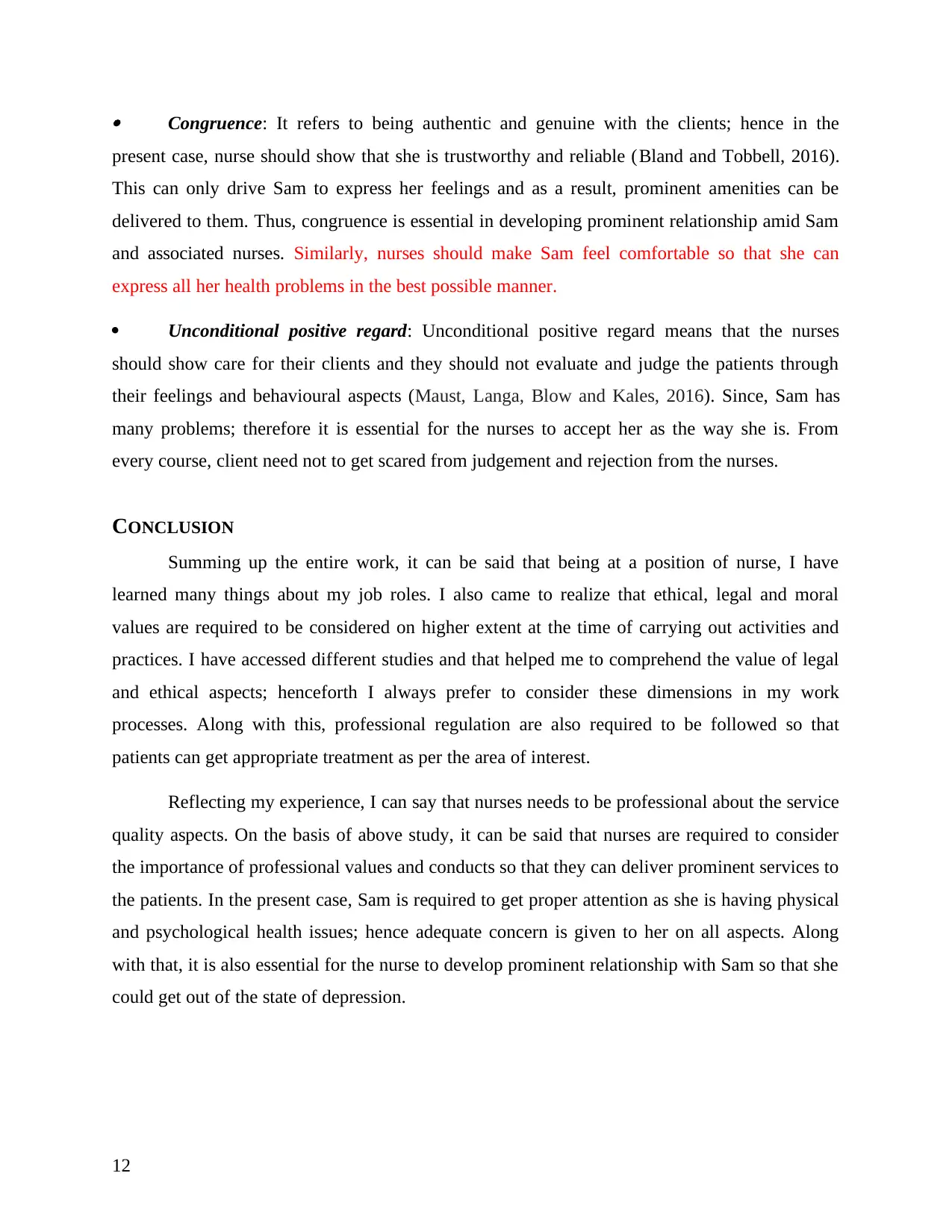
Congruence: It refers to being authentic and genuine with the clients; hence in the
present case, nurse should show that she is trustworthy and reliable (Bland and Tobbell, 2016).
This can only drive Sam to express her feelings and as a result, prominent amenities can be
delivered to them. Thus, congruence is essential in developing prominent relationship amid Sam
and associated nurses. Similarly, nurses should make Sam feel comfortable so that she can
express all her health problems in the best possible manner.
Unconditional positive regard: Unconditional positive regard means that the nurses
should show care for their clients and they should not evaluate and judge the patients through
their feelings and behavioural aspects (Maust, Langa, Blow and Kales, 2016). Since, Sam has
many problems; therefore it is essential for the nurses to accept her as the way she is. From
every course, client need not to get scared from judgement and rejection from the nurses.
CONCLUSION
Summing up the entire work, it can be said that being at a position of nurse, I have
learned many things about my job roles. I also came to realize that ethical, legal and moral
values are required to be considered on higher extent at the time of carrying out activities and
practices. I have accessed different studies and that helped me to comprehend the value of legal
and ethical aspects; henceforth I always prefer to consider these dimensions in my work
processes. Along with this, professional regulation are also required to be followed so that
patients can get appropriate treatment as per the area of interest.
Reflecting my experience, I can say that nurses needs to be professional about the service
quality aspects. On the basis of above study, it can be said that nurses are required to consider
the importance of professional values and conducts so that they can deliver prominent services to
the patients. In the present case, Sam is required to get proper attention as she is having physical
and psychological health issues; hence adequate concern is given to her on all aspects. Along
with that, it is also essential for the nurse to develop prominent relationship with Sam so that she
could get out of the state of depression.
12
present case, nurse should show that she is trustworthy and reliable (Bland and Tobbell, 2016).
This can only drive Sam to express her feelings and as a result, prominent amenities can be
delivered to them. Thus, congruence is essential in developing prominent relationship amid Sam
and associated nurses. Similarly, nurses should make Sam feel comfortable so that she can
express all her health problems in the best possible manner.
Unconditional positive regard: Unconditional positive regard means that the nurses
should show care for their clients and they should not evaluate and judge the patients through
their feelings and behavioural aspects (Maust, Langa, Blow and Kales, 2016). Since, Sam has
many problems; therefore it is essential for the nurses to accept her as the way she is. From
every course, client need not to get scared from judgement and rejection from the nurses.
CONCLUSION
Summing up the entire work, it can be said that being at a position of nurse, I have
learned many things about my job roles. I also came to realize that ethical, legal and moral
values are required to be considered on higher extent at the time of carrying out activities and
practices. I have accessed different studies and that helped me to comprehend the value of legal
and ethical aspects; henceforth I always prefer to consider these dimensions in my work
processes. Along with this, professional regulation are also required to be followed so that
patients can get appropriate treatment as per the area of interest.
Reflecting my experience, I can say that nurses needs to be professional about the service
quality aspects. On the basis of above study, it can be said that nurses are required to consider
the importance of professional values and conducts so that they can deliver prominent services to
the patients. In the present case, Sam is required to get proper attention as she is having physical
and psychological health issues; hence adequate concern is given to her on all aspects. Along
with that, it is also essential for the nurse to develop prominent relationship with Sam so that she
could get out of the state of depression.
12
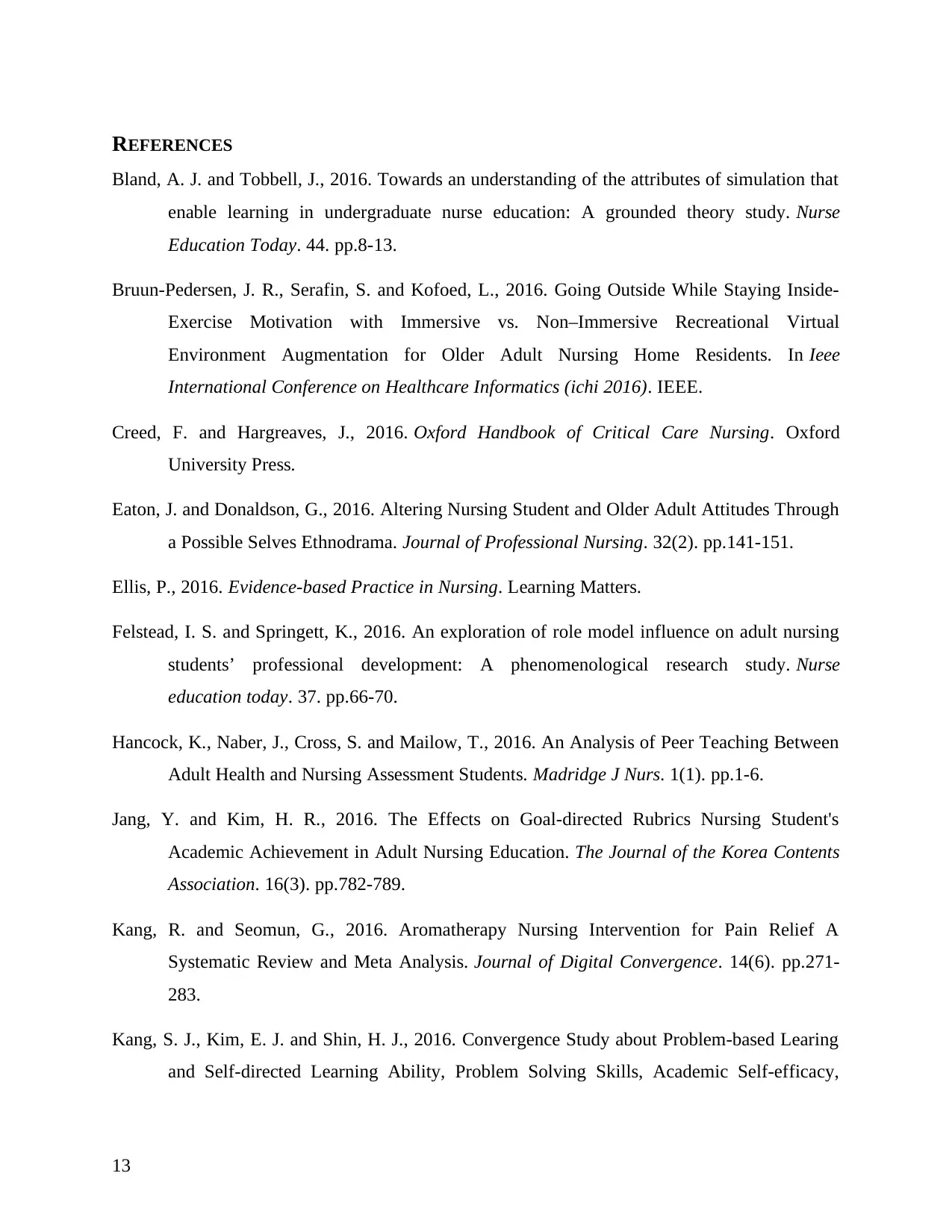
REFERENCES
Bland, A. J. and Tobbell, J., 2016. Towards an understanding of the attributes of simulation that
enable learning in undergraduate nurse education: A grounded theory study. Nurse
Education Today. 44. pp.8-13.
Bruun-Pedersen, J. R., Serafin, S. and Kofoed, L., 2016. Going Outside While Staying Inside-
Exercise Motivation with Immersive vs. Non–Immersive Recreational Virtual
Environment Augmentation for Older Adult Nursing Home Residents. In Ieee
International Conference on Healthcare Informatics (ichi 2016). IEEE.
Creed, F. and Hargreaves, J., 2016. Oxford Handbook of Critical Care Nursing. Oxford
University Press.
Eaton, J. and Donaldson, G., 2016. Altering Nursing Student and Older Adult Attitudes Through
a Possible Selves Ethnodrama. Journal of Professional Nursing. 32(2). pp.141-151.
Ellis, P., 2016. Evidence-based Practice in Nursing. Learning Matters.
Felstead, I. S. and Springett, K., 2016. An exploration of role model influence on adult nursing
students’ professional development: A phenomenological research study. Nurse
education today. 37. pp.66-70.
Hancock, K., Naber, J., Cross, S. and Mailow, T., 2016. An Analysis of Peer Teaching Between
Adult Health and Nursing Assessment Students. Madridge J Nurs. 1(1). pp.1-6.
Jang, Y. and Kim, H. R., 2016. The Effects on Goal-directed Rubrics Nursing Student's
Academic Achievement in Adult Nursing Education. The Journal of the Korea Contents
Association. 16(3). pp.782-789.
Kang, R. and Seomun, G., 2016. Aromatherapy Nursing Intervention for Pain Relief A
Systematic Review and Meta Analysis. Journal of Digital Convergence. 14(6). pp.271-
283.
Kang, S. J., Kim, E. J. and Shin, H. J., 2016. Convergence Study about Problem-based Learing
and Self-directed Learning Ability, Problem Solving Skills, Academic Self-efficacy,
13
Bland, A. J. and Tobbell, J., 2016. Towards an understanding of the attributes of simulation that
enable learning in undergraduate nurse education: A grounded theory study. Nurse
Education Today. 44. pp.8-13.
Bruun-Pedersen, J. R., Serafin, S. and Kofoed, L., 2016. Going Outside While Staying Inside-
Exercise Motivation with Immersive vs. Non–Immersive Recreational Virtual
Environment Augmentation for Older Adult Nursing Home Residents. In Ieee
International Conference on Healthcare Informatics (ichi 2016). IEEE.
Creed, F. and Hargreaves, J., 2016. Oxford Handbook of Critical Care Nursing. Oxford
University Press.
Eaton, J. and Donaldson, G., 2016. Altering Nursing Student and Older Adult Attitudes Through
a Possible Selves Ethnodrama. Journal of Professional Nursing. 32(2). pp.141-151.
Ellis, P., 2016. Evidence-based Practice in Nursing. Learning Matters.
Felstead, I. S. and Springett, K., 2016. An exploration of role model influence on adult nursing
students’ professional development: A phenomenological research study. Nurse
education today. 37. pp.66-70.
Hancock, K., Naber, J., Cross, S. and Mailow, T., 2016. An Analysis of Peer Teaching Between
Adult Health and Nursing Assessment Students. Madridge J Nurs. 1(1). pp.1-6.
Jang, Y. and Kim, H. R., 2016. The Effects on Goal-directed Rubrics Nursing Student's
Academic Achievement in Adult Nursing Education. The Journal of the Korea Contents
Association. 16(3). pp.782-789.
Kang, R. and Seomun, G., 2016. Aromatherapy Nursing Intervention for Pain Relief A
Systematic Review and Meta Analysis. Journal of Digital Convergence. 14(6). pp.271-
283.
Kang, S. J., Kim, E. J. and Shin, H. J., 2016. Convergence Study about Problem-based Learing
and Self-directed Learning Ability, Problem Solving Skills, Academic Self-efficacy,
13
Paraphrase This Document
Need a fresh take? Get an instant paraphrase of this document with our AI Paraphraser
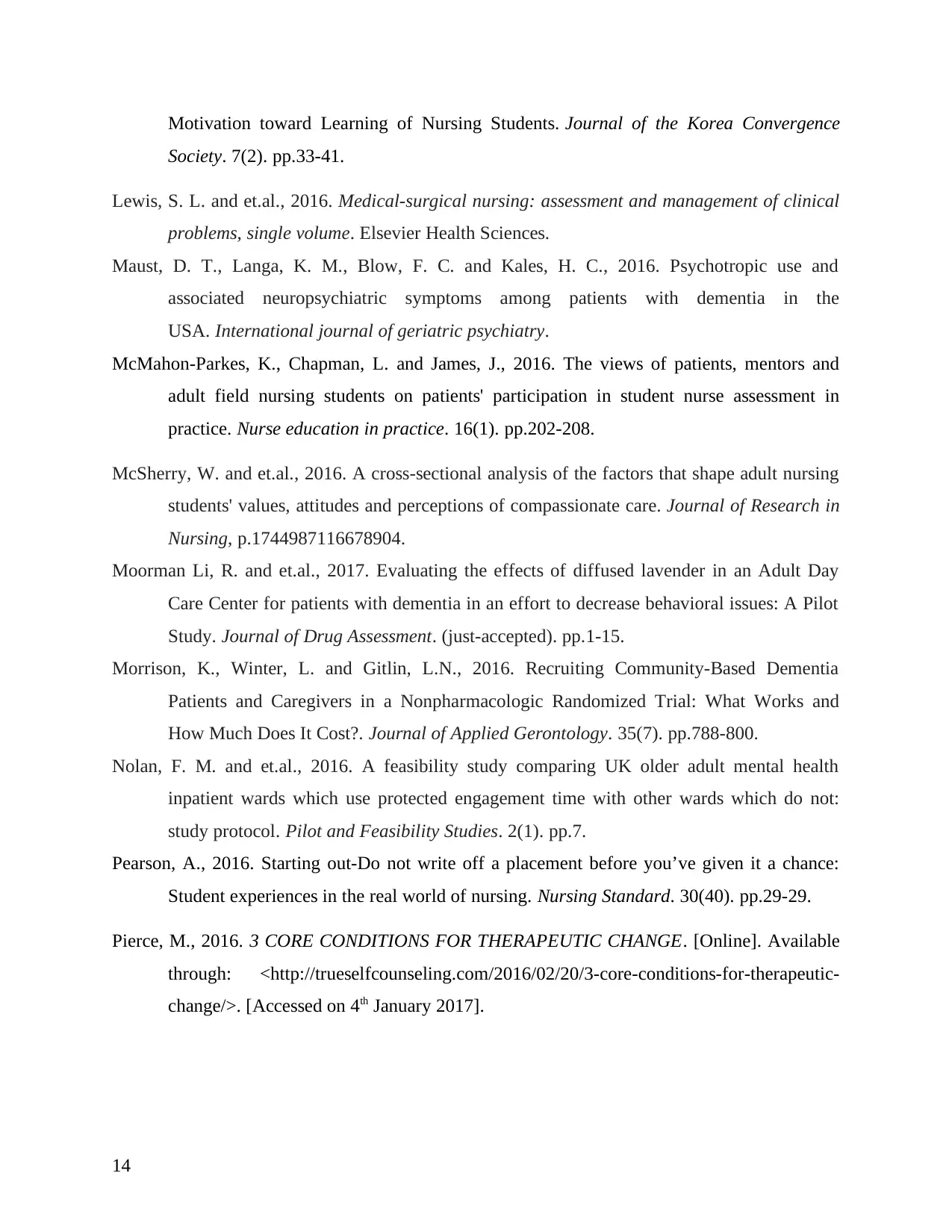
Motivation toward Learning of Nursing Students. Journal of the Korea Convergence
Society. 7(2). pp.33-41.
Lewis, S. L. and et.al., 2016. Medical-surgical nursing: assessment and management of clinical
problems, single volume. Elsevier Health Sciences.
Maust, D. T., Langa, K. M., Blow, F. C. and Kales, H. C., 2016. Psychotropic use and
associated neuropsychiatric symptoms among patients with dementia in the
USA. International journal of geriatric psychiatry.
McMahon-Parkes, K., Chapman, L. and James, J., 2016. The views of patients, mentors and
adult field nursing students on patients' participation in student nurse assessment in
practice. Nurse education in practice. 16(1). pp.202-208.
McSherry, W. and et.al., 2016. A cross-sectional analysis of the factors that shape adult nursing
students' values, attitudes and perceptions of compassionate care. Journal of Research in
Nursing, p.1744987116678904.
Moorman Li, R. and et.al., 2017. Evaluating the effects of diffused lavender in an Adult Day
Care Center for patients with dementia in an effort to decrease behavioral issues: A Pilot
Study. Journal of Drug Assessment. (just-accepted). pp.1-15.
Morrison, K., Winter, L. and Gitlin, L.N., 2016. Recruiting Community-Based Dementia
Patients and Caregivers in a Nonpharmacologic Randomized Trial: What Works and
How Much Does It Cost?. Journal of Applied Gerontology. 35(7). pp.788-800.
Nolan, F. M. and et.al., 2016. A feasibility study comparing UK older adult mental health
inpatient wards which use protected engagement time with other wards which do not:
study protocol. Pilot and Feasibility Studies. 2(1). pp.7.
Pearson, A., 2016. Starting out-Do not write off a placement before you’ve given it a chance:
Student experiences in the real world of nursing. Nursing Standard. 30(40). pp.29-29.
Pierce, M., 2016. 3 CORE CONDITIONS FOR THERAPEUTIC CHANGE. [Online]. Available
through: <http://trueselfcounseling.com/2016/02/20/3-core-conditions-for-therapeutic-
change/>. [Accessed on 4th January 2017].
14
Society. 7(2). pp.33-41.
Lewis, S. L. and et.al., 2016. Medical-surgical nursing: assessment and management of clinical
problems, single volume. Elsevier Health Sciences.
Maust, D. T., Langa, K. M., Blow, F. C. and Kales, H. C., 2016. Psychotropic use and
associated neuropsychiatric symptoms among patients with dementia in the
USA. International journal of geriatric psychiatry.
McMahon-Parkes, K., Chapman, L. and James, J., 2016. The views of patients, mentors and
adult field nursing students on patients' participation in student nurse assessment in
practice. Nurse education in practice. 16(1). pp.202-208.
McSherry, W. and et.al., 2016. A cross-sectional analysis of the factors that shape adult nursing
students' values, attitudes and perceptions of compassionate care. Journal of Research in
Nursing, p.1744987116678904.
Moorman Li, R. and et.al., 2017. Evaluating the effects of diffused lavender in an Adult Day
Care Center for patients with dementia in an effort to decrease behavioral issues: A Pilot
Study. Journal of Drug Assessment. (just-accepted). pp.1-15.
Morrison, K., Winter, L. and Gitlin, L.N., 2016. Recruiting Community-Based Dementia
Patients and Caregivers in a Nonpharmacologic Randomized Trial: What Works and
How Much Does It Cost?. Journal of Applied Gerontology. 35(7). pp.788-800.
Nolan, F. M. and et.al., 2016. A feasibility study comparing UK older adult mental health
inpatient wards which use protected engagement time with other wards which do not:
study protocol. Pilot and Feasibility Studies. 2(1). pp.7.
Pearson, A., 2016. Starting out-Do not write off a placement before you’ve given it a chance:
Student experiences in the real world of nursing. Nursing Standard. 30(40). pp.29-29.
Pierce, M., 2016. 3 CORE CONDITIONS FOR THERAPEUTIC CHANGE. [Online]. Available
through: <http://trueselfcounseling.com/2016/02/20/3-core-conditions-for-therapeutic-
change/>. [Accessed on 4th January 2017].
14
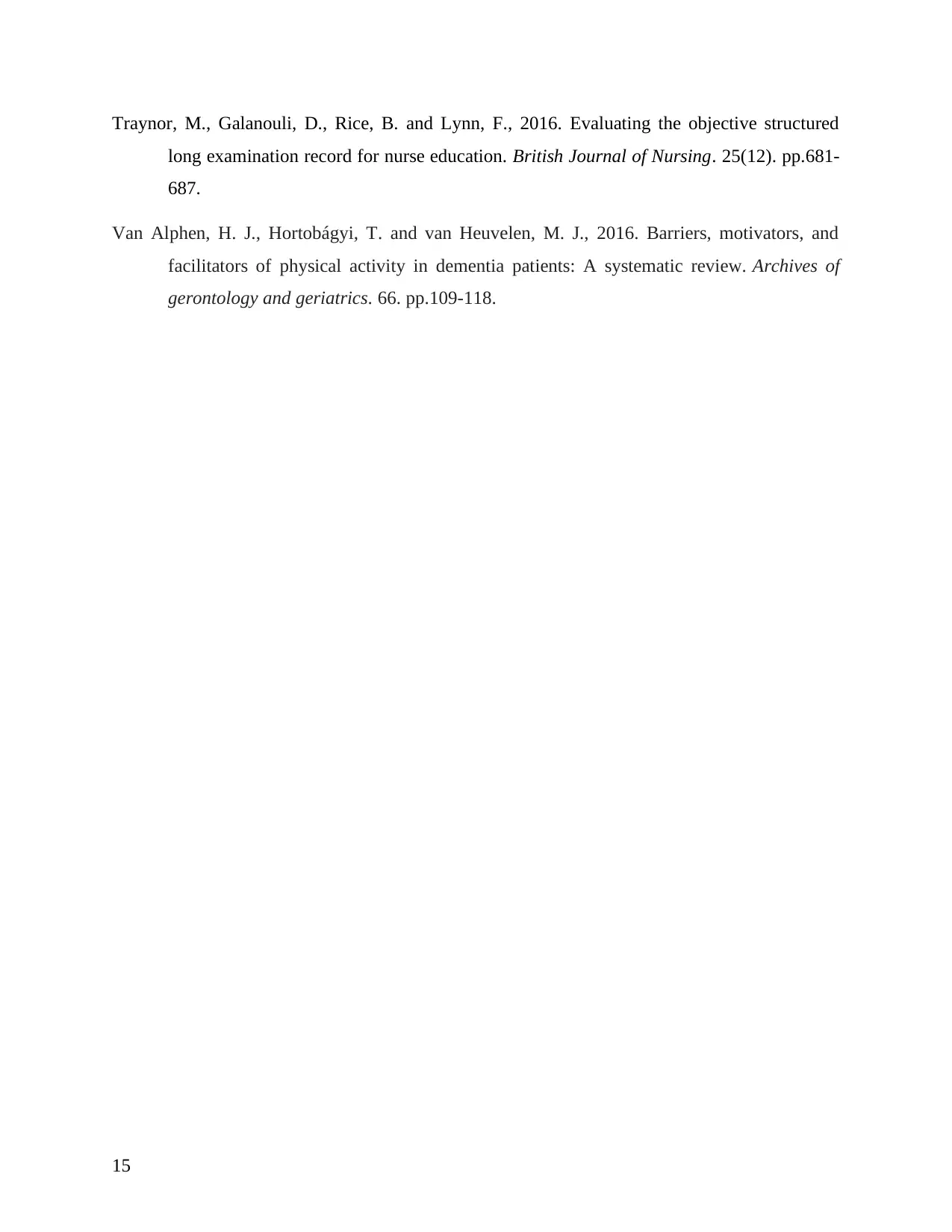
Traynor, M., Galanouli, D., Rice, B. and Lynn, F., 2016. Evaluating the objective structured
long examination record for nurse education. British Journal of Nursing. 25(12). pp.681-
687.
Van Alphen, H. J., Hortobágyi, T. and van Heuvelen, M. J., 2016. Barriers, motivators, and
facilitators of physical activity in dementia patients: A systematic review. Archives of
gerontology and geriatrics. 66. pp.109-118.
15
long examination record for nurse education. British Journal of Nursing. 25(12). pp.681-
687.
Van Alphen, H. J., Hortobágyi, T. and van Heuvelen, M. J., 2016. Barriers, motivators, and
facilitators of physical activity in dementia patients: A systematic review. Archives of
gerontology and geriatrics. 66. pp.109-118.
15

APPENDIX
16
16
Secure Best Marks with AI Grader
Need help grading? Try our AI Grader for instant feedback on your assignments.
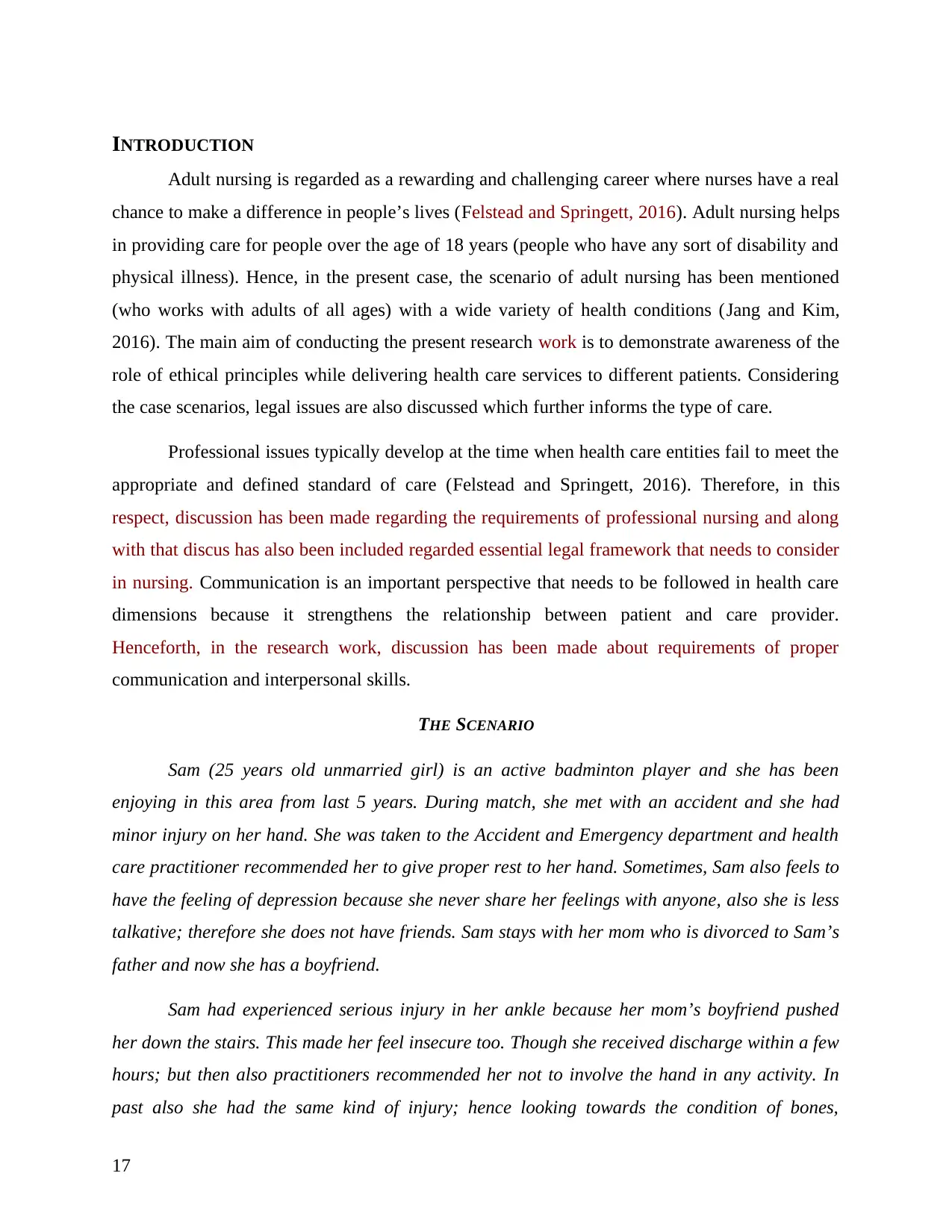
INTRODUCTION
Adult nursing is regarded as a rewarding and challenging career where nurses have a real
chance to make a difference in people’s lives (Felstead and Springett, 2016). Adult nursing helps
in providing care for people over the age of 18 years (people who have any sort of disability and
physical illness). Hence, in the present case, the scenario of adult nursing has been mentioned
(who works with adults of all ages) with a wide variety of health conditions (Jang and Kim,
2016). The main aim of conducting the present research work is to demonstrate awareness of the
role of ethical principles while delivering health care services to different patients. Considering
the case scenarios, legal issues are also discussed which further informs the type of care.
Professional issues typically develop at the time when health care entities fail to meet the
appropriate and defined standard of care (Felstead and Springett, 2016). Therefore, in this
respect, discussion has been made regarding the requirements of professional nursing and along
with that discus has also been included regarded essential legal framework that needs to consider
in nursing. Communication is an important perspective that needs to be followed in health care
dimensions because it strengthens the relationship between patient and care provider.
Henceforth, in the research work, discussion has been made about requirements of proper
communication and interpersonal skills.
THE SCENARIO
Sam (25 years old unmarried girl) is an active badminton player and she has been
enjoying in this area from last 5 years. During match, she met with an accident and she had
minor injury on her hand. She was taken to the Accident and Emergency department and health
care practitioner recommended her to give proper rest to her hand. Sometimes, Sam also feels to
have the feeling of depression because she never share her feelings with anyone, also she is less
talkative; therefore she does not have friends. Sam stays with her mom who is divorced to Sam’s
father and now she has a boyfriend.
Sam had experienced serious injury in her ankle because her mom’s boyfriend pushed
her down the stairs. This made her feel insecure too. Though she received discharge within a few
hours; but then also practitioners recommended her not to involve the hand in any activity. In
past also she had the same kind of injury; hence looking towards the condition of bones,
17
Adult nursing is regarded as a rewarding and challenging career where nurses have a real
chance to make a difference in people’s lives (Felstead and Springett, 2016). Adult nursing helps
in providing care for people over the age of 18 years (people who have any sort of disability and
physical illness). Hence, in the present case, the scenario of adult nursing has been mentioned
(who works with adults of all ages) with a wide variety of health conditions (Jang and Kim,
2016). The main aim of conducting the present research work is to demonstrate awareness of the
role of ethical principles while delivering health care services to different patients. Considering
the case scenarios, legal issues are also discussed which further informs the type of care.
Professional issues typically develop at the time when health care entities fail to meet the
appropriate and defined standard of care (Felstead and Springett, 2016). Therefore, in this
respect, discussion has been made regarding the requirements of professional nursing and along
with that discus has also been included regarded essential legal framework that needs to consider
in nursing. Communication is an important perspective that needs to be followed in health care
dimensions because it strengthens the relationship between patient and care provider.
Henceforth, in the research work, discussion has been made about requirements of proper
communication and interpersonal skills.
THE SCENARIO
Sam (25 years old unmarried girl) is an active badminton player and she has been
enjoying in this area from last 5 years. During match, she met with an accident and she had
minor injury on her hand. She was taken to the Accident and Emergency department and health
care practitioner recommended her to give proper rest to her hand. Sometimes, Sam also feels to
have the feeling of depression because she never share her feelings with anyone, also she is less
talkative; therefore she does not have friends. Sam stays with her mom who is divorced to Sam’s
father and now she has a boyfriend.
Sam had experienced serious injury in her ankle because her mom’s boyfriend pushed
her down the stairs. This made her feel insecure too. Though she received discharge within a few
hours; but then also practitioners recommended her not to involve the hand in any activity. In
past also she had the same kind of injury; hence looking towards the condition of bones,
17
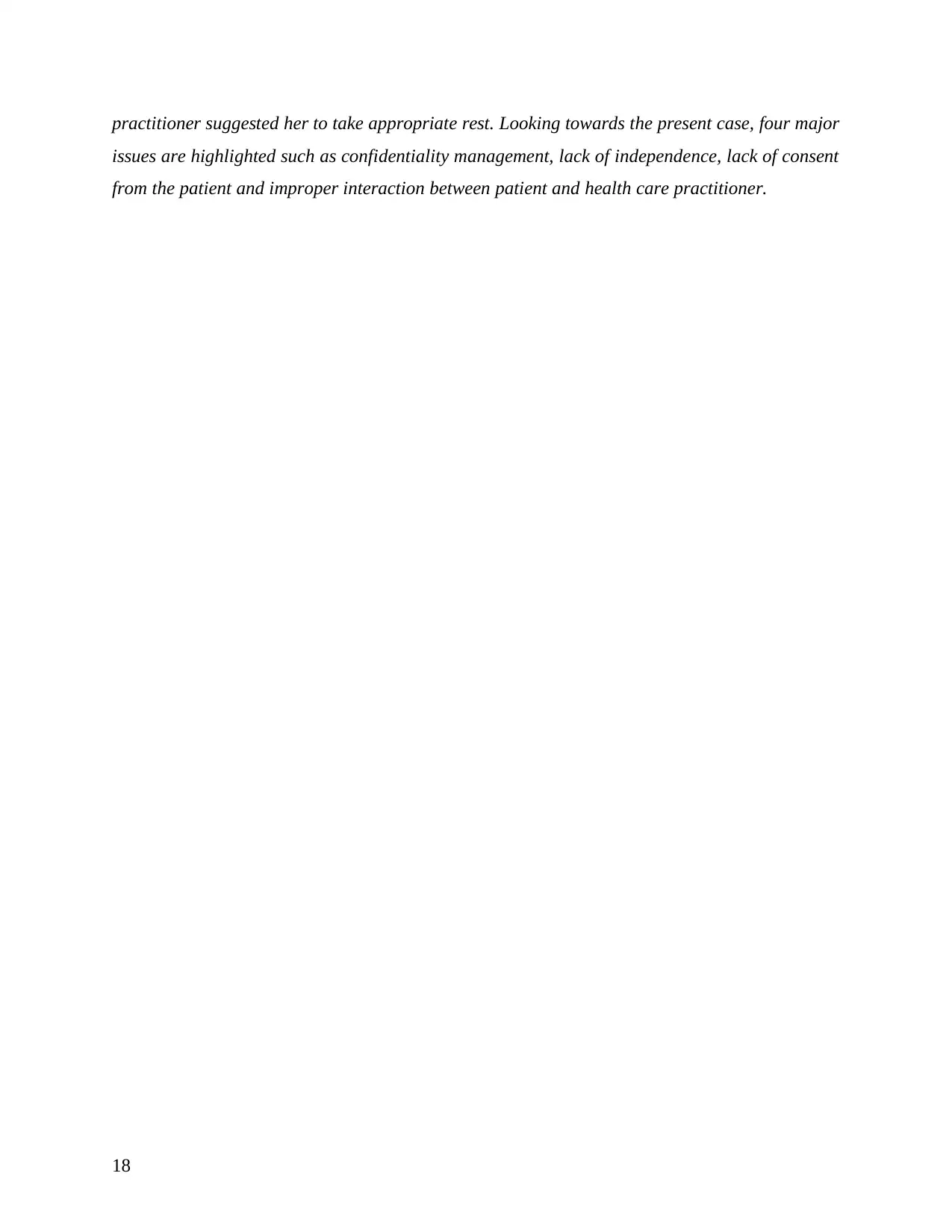
practitioner suggested her to take appropriate rest. Looking towards the present case, four major
issues are highlighted such as confidentiality management, lack of independence, lack of consent
from the patient and improper interaction between patient and health care practitioner.
18
issues are highlighted such as confidentiality management, lack of independence, lack of consent
from the patient and improper interaction between patient and health care practitioner.
18
1 out of 18
Related Documents
Your All-in-One AI-Powered Toolkit for Academic Success.
+13062052269
info@desklib.com
Available 24*7 on WhatsApp / Email
![[object Object]](/_next/static/media/star-bottom.7253800d.svg)
Unlock your academic potential
© 2024 | Zucol Services PVT LTD | All rights reserved.




